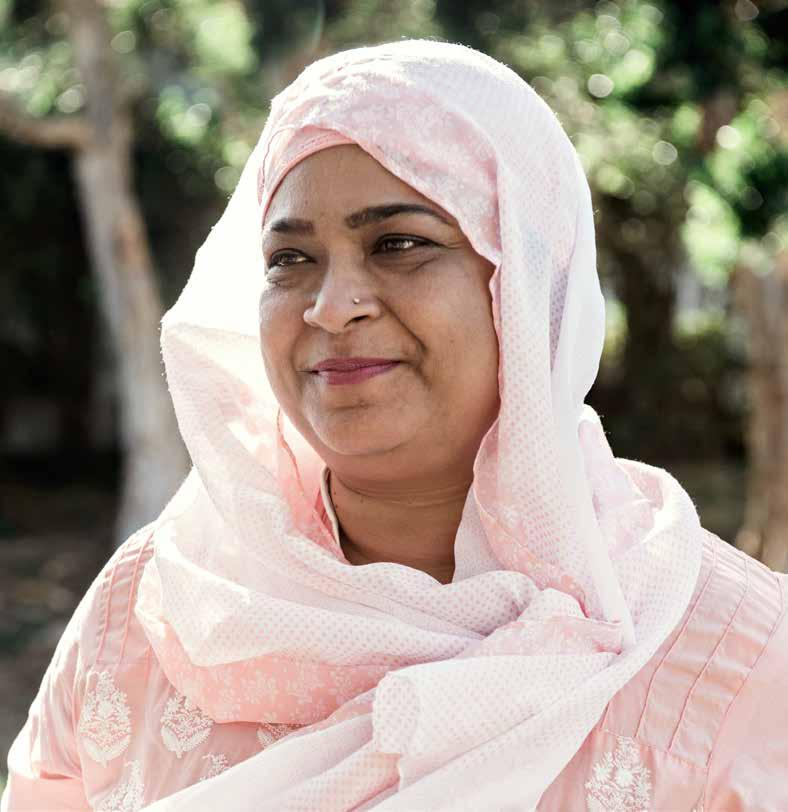
THE MIGRATION ISSUE DISPLAY UNTIL JULY 30, 2016 SUMMER 2016 MAUI’S ENDEMIC BIRDS PRAYER WARRIORS FACES OF ISLAM


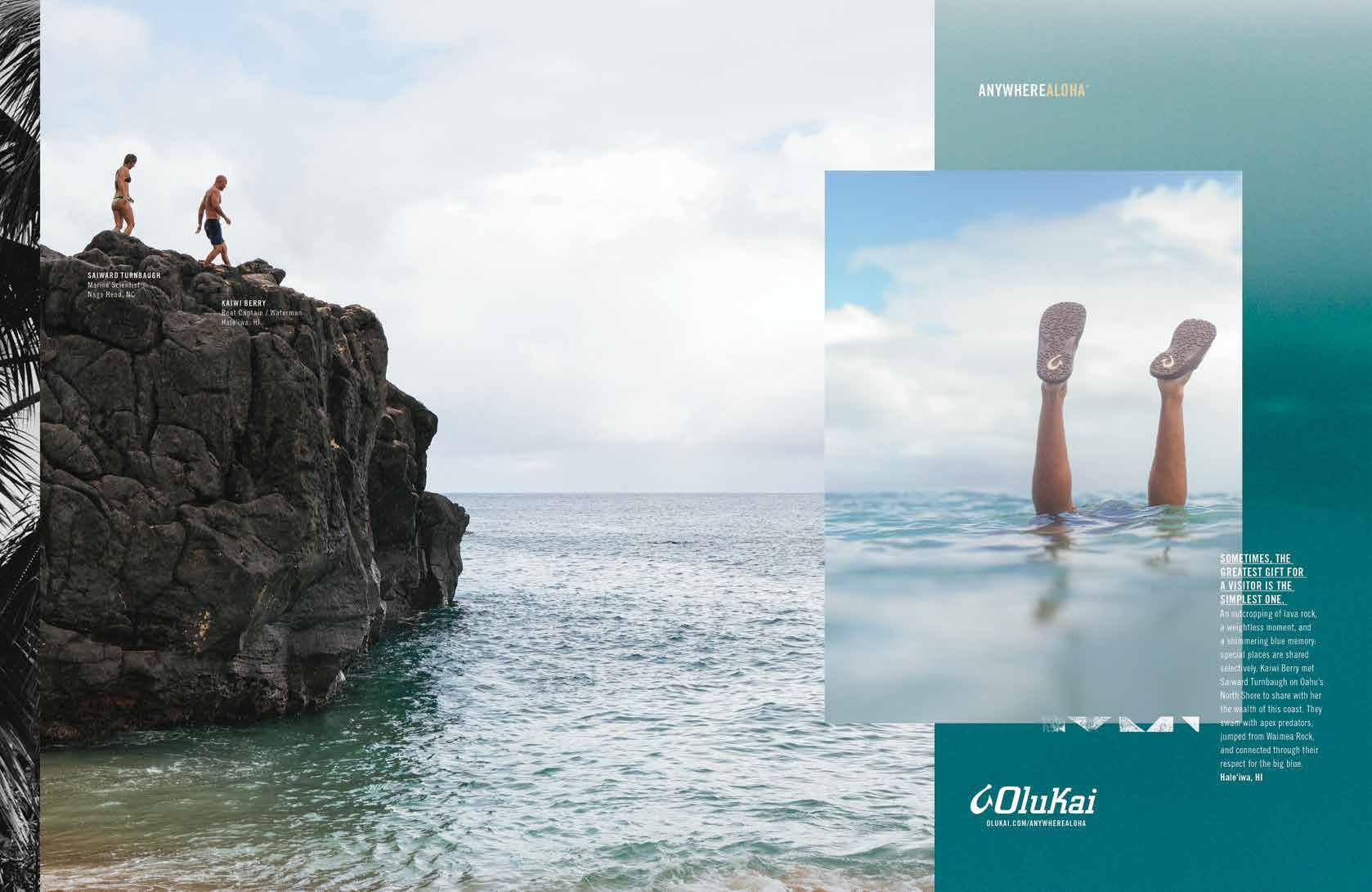


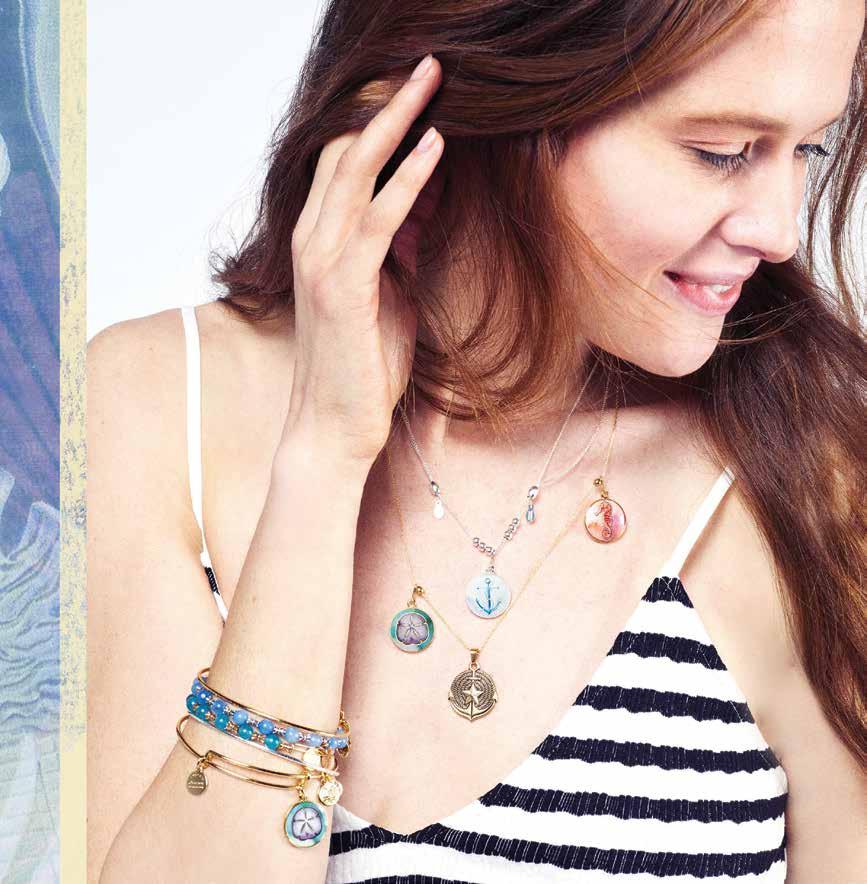
shop the exclusive ALOHA BANGLE
ALA MOANA NOW OPEN | ALA MOANA CENTER, EWA WING
LAS VEGAS Miracle Mile Shops • McCarran International Airport: D Gates
Grand Bazaar Shops • Grand Canal Shoppes The Palazzo | The Venetian
Fashion Show Mall, Open May 2016



ALEX AND ANI creates meaningful, eco-conscious jewelry and accessories to empower and connect you. We share a passion for the well-being of our planet, our communities, and our individual paths.
ALEX AND ANI creates meaningful, eco-conscious jewelry and accessories to empower and connect you. We share a passion for the well-being of our planet, our communities, and our individual paths.
MADE IN AMERICA WITH LOVE ® ALEXANDANI . COM
MADE
ALEXANDANI
IN AMERICA WITH LOVE ®
COM
TABLE OF CONTENTS
42 | Foreign Ambassador
As the senior geographer at the Smithsonian Institute National Museum of the American Indian in the nation’s capital, Doug Herman has become one of Hawai‘i’s most ardent cultural advocates—though he’s not native himself. Timothy Schuler examines the role of outsiders in native and minority communities.
52 | Prayer Warriors
For Korean immigrants that arrived to Hawai‘i in 1903, the Christian church came to signify stability, camaraderie, and progress. Editor Lisa Yamada explores the relevance of the ageold institution in the isles.
62 | Faces of Hawai‘i’s Islam
Unlike the simplistic, sensational picture the media draws of Muslims, those of Islamic faith make up a diverse, global population. Brad Dell talks to four such individuals who have made Hawaiʻi their home.
82 | Special Section:
Escape!
It is only too easy to forget about the bounty of adventure that awaits in our own backyards. Discover refreshing ways to take a vacation in this special summer travel section, whether it’s exploring a remote location on a neighbor island for the frst time or looking diferently at a place we’ve known our whole lives.

| 30 |
Fight or Flight
By migration and by accident, birds arrived in the Hawaiian-Emperor archipelago of atolls and islands over the course of several millennia. Editor-at-large Sonny Ganaden explores how avian scientists just may save both bird and man from the efects of a warming world.
6 | FLUXHAWAII.COM
|
|
FEATURES

Editor’s Letter
Contributors
Letters to the Editor
18 | What the Flux?! Making Moves

24 | Art : Omer Kursat
28 | Art : Linny Morris IN FLUX 70 | Food : Olay’s Thai Express
74 | Food : Hide Sakurai 78 | Views : icronesia s igrant risis


Local Moco
As one of the last remaining sakadas alive to tell his tale, Cipriano Erice recounts what life on Hawai‘i’s plantations was like for Filipino laborers who arrived between 1906 and 1946.
8 | FLUXHAWAII.COM TABLE OF CONTENTS | DEPARTMENTS |
FLUX PHILES
A HUI HOU
112 | Making Pâté de Lapin
| 20 |
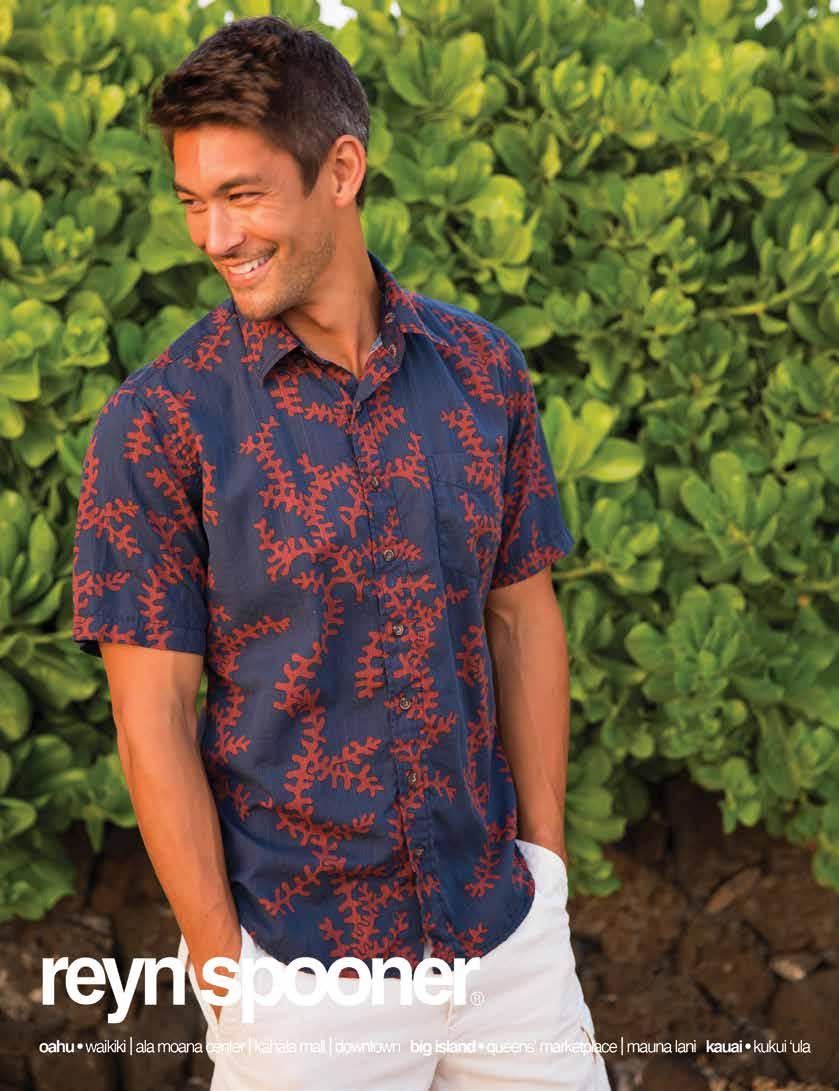

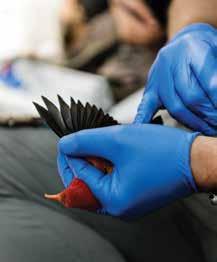
VIDEO: CHASING BIRDS ON MAUI
In this video by Philip Lemoine, go behind the scenes with editor-at-large Sonny Ganaden and photographer John Hook as they accompany Maui Bird Recovery’s avian biologist Chris Warren through the Kula Forest Reserve on the leeward slope of Haleakalā on Maui.
ON THE COVER:
Shown on the cover is Nighat Quadri, who is part of the .05 percent of Hawai‘i’s population that declare Islam their religion. Quadri emigrated from Pakistan to the United States in 1997, after her husband won a lottery for immigration to America. Tough the Muslim community has been hurt by negative portrayals, Quadri says the people of Hawai‘i are welcoming. “I felt the spirit of aloha right away,” she says. Read Quadri’s story on page 62.
may be a quarterly, but we’re bringing stories all the time online.
STAY CURRENT ON ARTS AND CULTURE WITH US AT:
fluxhawaii.com facebook /fluxhawaii twitter @fluxhawaii instagram @fluxhawaii
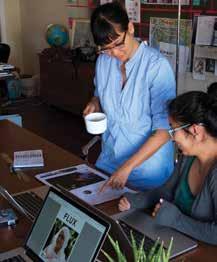
NOTICE ANYTHING DIFFERENT?
Hey, we got redesign! Creative director Ara Feducia discusses the design inspiration and processes behind FLUX Hawaii’s new look.

CONTEST: #FLUXROOTS
Tell your mom you love her. Tell your dad you care. Shout out your motherland and share with us the story of your migratory roots on Instagram, and tag @fluxhawaii #fluxroots between June 1 and June 20, 2016. A random contributor who posts during this time will win a FLUX prize pack.
Shown here is the Torres family, whose portrait was taken circa 1958, about 11 years after they arrived to Hawai‘i from Luzon island in the Philippines. The family’s patriarch, Primitivo, first came to Hawai‘i in 1946 to work for the Honoka‘a Sugar Plantation, and his family would join him a year later.
10 | FLUXHAWAII.COM TABLE OF
| FLUXHAWAII.COM |
CONTENTS
IMAGE SHOT BY JOHN HOOK
We

When grisly scenes from around the world confront our daily lives, we do our best to look away—to avoid seeing the blood in the streets, the blown out windows of buses and buildings, the shocked faces of those who have just escaped with their lives, the dejection of those waiting to start new ones.
Yet it’s all too easy to get caught up in the frenzy that arises from con ict. e b ild walls and reinforce borders to keep them o t to keep s safe. prime e ample and one that is fo nd right here at home early Hawai i residents signed a petition titled top yrian ef gees from entering Hawaii and the after o ernor Ige said the state would welcome these refugees in the days following the terrorist attacks in Paris in November 2015. (This despite the fact that there has not been a single refugee involved in an act of terrorism in the United States since the country’s refugee resettlement program began in 1980; not to mention that all but one of the known assailants in the recent attacks in Paris and Belgium were European-born citizens, and all were raised in the EU.)
Fear is a powerful rhetoric. It was employed not so long ago on our very shores, when race prejudice and war hysteria marginalized an entire comm nity of apanese mericans. ap s a ap eneral ohn e itt famo sly said of internment. t makes no diference whether the ap is a citi en or not. nd while we like to tell o rsel es that hindsight is o are kidding yo rself if yo think the same thing will not happen again the late stice ntonin calia warned a group of University of Hawai‘i law students in 2014, predicting that the Supreme Court would eventually authorize another impediment on civil rights similar to that which happened with Japanese internment d ring orld ar . t was wrong b t wo ld not be s rprised to see it happen again in time of war. t s no stifcation b t it is the reality.
In Hawai‘i, it can be easy to ignore what is happening around the world, to quickly turn the page from the headline stories playing out far from our isles. After all, it is unlikely that the migrant crisis unfolding in Europe will ever reach Hawai‘i’s shores. But we can still put up borders, draw boundary lines around our neighborhoods, and cast blame on those who arrive in need. Nowhere does the cool shrug of indiference feel harsher than in the aloha state a place flled with migrants who traveled from Polynesia, Asia, and around the world. We are only too pro d to call o rsel es the melting pot of the acifc.
This, our Migration issue, celebrates the diversity of peoples— traveled from near and far—reminding us that no man is an island, and that we are all really foreigners, even in a place as familiar as our island home.
With aloha,
Lisa Yamada EDITOR lisa@nellamediagroup.com
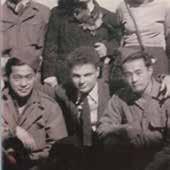
o man is an island / Every man is a piece of the continent / A part of the main / Any man’s death diminishes me / Because I am involved in mankind.
—John Donne, Devotions Upon Emergent Occasions
The editor’s grandfather, shown left, with the 442nd Regimental Combat Team during World War II.

12 | FLUXHAWAII.COM EDITOR'S LETTER |
|
MIGRATION

How did you get here?
PUBLISHER
Jason Cutinella
EDITOR
Lisa Yamada
CREATIVE DIRECTOR
Ara Feducia
“My family emigrated from the Philippines when I was 7. As an American, my heritage is the foundation of why I believe teaching arts and culture to young people is important.”
MANAGING EDITOR
Anna Harmon
DESIGNER
Michelle Ganeku
PHOTOGRAPHY DIRECTOR
John Hook
PHOTO EDITOR
Samantha Hook
COPY EDITOR
Andy Beth Miller
EDITOR - AT - LARGE
Sonny Ganaden
IMAGES
Bryce Johnson
Jonas Maon
IJfke Ridgley
Haren Soril
“My Japanese and Chinese ancestors originally came to Hawai‘i to work on the plantations. My greatgreat grandpa, Young Anin, actually founded Oahu Market in Chinatown. I’ve always admired their hard work and humility.”
CONTRIBUTORS
Tess Bevernage
Martha Cheng
Brad Dell
Tina Grandinetti
Kelli Gratz
Christa Hester
Rebecca Pike
IJfke Ridgley
Timothy A. Schuler
Haren Soril
WEB DEVELOPER
Matthew McVickar
ADVERTISING
Mike Wiley
GROUP PUBLISHER mike@nellamediagroup.com
Keely Bruns
MARKETING & ADVERTISING DIRECTOR keely@nellamediagroup.com
Chelsea Tsuchida MARKETING & ADVERTISING EXECUTIVE
Carrie Shuler
MARKETING & CREATIVE COORDINATOR
©2009-2016 by Nella Media Group, LLC. Contents of FLUX Hawaii are protected by copyright and may not be reproduced without the expressed written consent of the publisher.
FLUX Hawaii accepts no responsibility for unsolicited manuscripts and/or photographs and assumes no liability for products or services advertised
OPERATIONS
Joe V. Bock CHIEF OPERATING OFFICER joe@nellamediagroup.com
Gary Payne VP BUSINESS DEVELOPMENT gpayne@nellamediagroup.com
Jill Miyashiro
OPERATIONS DIRECTOR jill@nellamediagroup.com
Mitchell Fong JUNIOR DESIGNER
General Inquiries: contact@fluxhawaii.com
“My grandfather arrived to Hawai‘i from Munich, Germany by steamship more than 100 years ago to manage the old McInerny’s downtown retail store, eventually opening his own men’s shop at the current Ross location in downtown Honolulu.”
PUBLISHED BY: Nella Media Group 36 N. Hotel Street, Suite A Honolulu, HI 96817
herein. FLUX Hawaii reserves the right to edit, rewrite, refuse or reuse material, is not responsible for errors and omissions and may feature same on hawaii.com as well as other mediums for any and all purposes.
FLUX Hawaii is a quarterly lifestyle publication.
14 | FLUXHAWAII.COM
| MIGRATION |
MASTHEAD



IJfke Ridgley
Born into a military family, Brad Dell has migrated every few years for most of his life, but decided to call Hawai‘i home because of his love for experiencing the myriad of cultures that have blended together here as a result of migrations from across the globe. He got to learn more abo t this in of c lt res while writing aces of Hawai i s slam on page . ears were shed d ring chats abo t the prejudices of media and people, and about the status of their homes, but there was plenty of smiling when talking about the tight-knit community of people with diferent backgro nds b t a shared faith shares Dell of his experience interviewing members of Hawai‘i’s Islamic community.
For O‘ahu local IJfke Ridgley, interviewing Cipriano Erice, one of Hawai‘i’s last remaining sakadas, or Filipino laborers, was a great way to peek into the history of the island story on page . t was surprising and touching what fond memories Cipriano had about life at the sugar plantation, and how modest he was abo t the role he played in its history she says. When not writing, Ridgley enjoys the challenge of making her photography as colorful and creative as possible, whether for fashion or tra el. s a shooting location she says Hawai i really is endlessly inspiring.
 Timothy A. Schuler
Timothy A. Schuler
A contributing editor at Landscape Architecture Magazine, Kansas-born Timothy A. Schuler gained an appreciation for the natural environment from his parents (a landscape designer and soil conservationist), who took the family on annual vacations to some of North America’s most remote places. Schuler tra eled to one s ch location H ena on Kaua‘i’s north shore, to interview Doug Herman, a senior geographer at the Smithsonian and a Hawaiian cultural ad ocate. m certain now that part of the reason I was interested in telling Doug’s story is because, as someone who is not Native Hawaiian and who wasn’t born here, I continue to have questions about my role in Hawai i ch ler says.
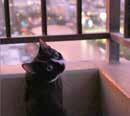





I always read FLUX page by page, and this spring edition touched me in so many ways. My mother has been paralyzed on her left side for 10 years, and between my sister, daughter and me, we care for her. However, a few years ago, I arranged to have Yolanda stay with her from 8 a.m. to 3 p.m. There is now a bond between them, and mom en oys her company. hat a diference in ha ing that social interaction since we are all on diferent b sy sched les
Keep up the great work!
Aloha McGuffie
16 | FLUXHAWAII.COM CONTRIBUTORS & LETTERS | MIGRATION |
Brad Dell
We welcome and value your feedback. SEND LETTERS TO THE EDITOR VIA EMAIL TO: lisa@nellamediagroup.com or mail to FLUX Hawaii, 36 N. Hotel St., Suite A, Honolulu, HI 96817 We asked our readers to post pics of their furry friends and tag them bestie. Here s a few for yo r viewing pleasure. You’re welcome. @ ALIIVET @ ISABELLA_N_BEAU @ KOSS__BOSS @ THISPUGOLIVE 77 76 “I think she tops,” says 91-year-old Jean Yamada her live-in caregiver, Lourdes Vivar Noble. “But she isn’t always tops.” bare whisper: “She gets awfully conceited if she thought was only saying good things about her.” Playful banter between Noble and Jean, says. wish could say the same,” Jean’s cheeky retort. While their relationship predicated on assertiveness and wit, it is calls loving, caring, and considerate of her needs. Is Noble tired? Jean encourages her to rest. “Very few clients are like her, most who views Jean and her family as her own. “Caregiving thinking of the other person instead of yourself,” she says. “You are giving yourself the other person.” early 2014, Jean (who is, in full disclosure, the grandmother FLUX Hawaii’s editor) was diagnosed with dementia. She moved temporarily her Noble first cared for her on part-time basis an employee of home care agency Attention Plus Care. Jean, who sometimes has trouble remembering names, came up what we were doing Mililani,” Noble ey also talked about the white moonflower that only blooms at night and thrown away, and said can make them live,” Noble recalls. at plant, after two months, bloomed. … And from then on she called me the Orchid Lady.” topped out at 18, her family decided one live-in caregiver could provide more ered the position to Noble, who accepted. Before moving into Jean’s home in ‘Aiea, Noble took month-long vacation to the Philippines, where she from. When she returned, she found Jean’s health had deteriorated. T dangerously low 86 pounds. Her family Working with the family and Jean’s parttime caregivers, Noble, like she had done and the coconut trees, and then she’d forget about saying she didn’t like to eat,” Noble What Noble’s nickname today? “Sexy Wexy,” says Noble, who demonstrates how she wiggles her hips when she exercises, or when she teases Jean make her laugh. never forgets that Sexy Wexy thing,” she says, beaming with pride and, even, hint NOBLE LADIES:
Correction page 36, Companions Issue: FLUX Hawaii incorrectly printed the name of the 15-year-old cowgirl. Her name is Caysie Medeiros, not Madeiros.

Making Moves
How did we get here? Facts on immigration, then and now.
COMPILED BY
ANNA HARMON
Hawai‘i was settled by immigrants from Polynesia who stayed so long that their culture and language became unique to the islands. During this time, the world population was both nomadic and sedentary, and national borders were in flux. In the 1800s, in the height of worldwide colonialism, immigrants from Europe and the United States arriving to Hawai‘i drastically changed the
way of life, both by greatly traumatizing the Native Hawaiian population and introducing a new political, religious, and economic system. This system needed laborers, and so immigrants largely from China, Japan, and the Philippines came to the islands. In 1898, when Hawai‘i became a U.S. territory, the flow of people to the islands began to be regulated by a federal system that was reactionary and
bigoted (take the Chinese Exclusion act of 1882).
Since then, policies have been implemented, quotas have been tweaked, and immigration continues to flow as people seek economic opportunity, easy retirement, healthcare, reunion with family, better lives for their children, escape from persecution, and refuge from natural disasters and war.
OVERVIEW:
46 ,782
Number of foreigners who moved to Hawai‘i from 2010 to 2015
18 %
Percent of small business owners in the U.S. who are immigrants. This is a higher share compared to U.S.-born workers.
Immigrants comprised 20.5% of Hawai‘i’s workforce in 2013, according to the U.S. Census Bureau. In the United States as a whole, there are almost as many immigrants in whitecollar jobs (46 percent) as in all other occupations combined.
HAWAI‘I:
250,000 foreign-born * (17.6% of total population; U.S. average is 13.3%)
* “Foreign born” includes naturalized U.S. citizens, green-card holders, refugees and asylees, certain legal nonimmigrants, and unauthorized immigrants.
UNAUTHORIZED IMMIGRANTS
DEFINED: Immigrants living in the U.S. without a visa or green card.
ECONOMIC IMPACT:
$31 . 2 million +
The amount unauthorized immigrants in Hawai‘i paid in state and local taxes in 2012
$7 billion+
The estimated amount unauthorized immigrants paid in Social Security taxes in 2005— benefits they will never be able to reclaim
GLOBAL WARMING
250 million
The amount of people anticipated to be displaced by climate change impacts worldwide by 2050. An estimated 665,000 to 1.7 million of these are estimated to be people from the Pacific.
WHAT THE FLUX | MIGRATION
|
HOW DID WE GET HERE? 1798 Alien Enemies Act: Authorizes imprisonment or deportment of male citizens from countries considered enemies of war. 1882 Chinese Exclusion Act: Prohibits the immigration of Chinese laborers. 1924 Immigration Act: Limits immigration from Southern and Eastern Europe to keep out those deemed “dangerous,” sentiments of the first Red Scare and eugenics movement. 1948 Displaced Persons Act: Relocates 400,000 displaced Europeans after World War II; four years later, Asian exclusion overturned.
1790 Naturalization Act: Excludes non-whites from eligibility to naturalize.
DEFINED:
Immigrants given entry to the U.S. with potential path to citizenship, including those relocating with sponsorship, to be with family or for work, those selected by lottery for diversity visas (countries with low immigration to the U.S.), refugees, and asylees, as well as naturalized citizens.
Since 1975, the U.S. has resettled more than 3 million refugees, with annual admissions figures ranging from a high of 207,000 in 1980 to a low of 27,110 in 2002.
59. 5 million
The number of refugees and asylees worldwide at the end of 2014, the highest ever recorded .
20 to 30 percent of refugees live in temporary camps. The average stay is 17 years.
NONIMMIGRANTS
DEFINED: Legal nonimmigrants are given temporary entry to the U.S., but have no path to citizenship (ex. temporary laborers, students), and include Compact of Free Association migrants from Micronesia.
*However, for Social Security cards, the U.S. treats COFA migrants as “lawfully admitted for permanent residence.”
4 , 812 , 993
The number of registered Syrian refugees as of March 16, 2016 13 , 947
The number of Hawai‘i residents who signed a petition on change. org titled, “Stop Syrian Refugees from entering Hawaii and the USA” after Governor Ige says Hawai‘i will welcome them.

1982 : 670 refugees
Top countries of origin: Vietnam, Cambodia, Laos
2014 : 2 refugees
Only country of origin: Burma
1 , 800
The number of Syrian refugees the U.S. has accepted since the crisis began, 62 percent of which are women and children under 12. President Obama says the U.S. will take 10,000 Syrian refugees in 2016.

US
1982 : 97,000 refugees
Top countries of origin: Cambodia, Vietnam, Laos
2014 : 69, 987 refugees
Top countries of origin: Iraq, Burma, Somalia, Bhutan
Immigration Reform Act: Seeks to prevent flow of undocumented immigrants to the U.S.
14 ,700
Estimated number of COFA migrants in Hawai‘i in 2013
Total COFA migrants in U.S. in 2008: 56,345 In Hawai‘i: 12,060
ECONOMIC IMPACT:
COFA migrants living in Hawai‘i pay all federal, state, and local taxes (from sales to income tax), payroll deductions, and other government fees, including social security, which they are ineligible to receive.
COFA migrants are ineligible to receive benefits such as financial assistance, food stamps and federal Medicaid. The few exceptions are that they can receive Temporary Assistance for Other Needy Families funds (an alternative to TANF); pregnant women and children can get Medicaid, and elderly and disabled can get statefunded medical assistance.
area. This is after the American military conducted 67 nuclear tests in the Marshall Islands. Congress restricts COFA access to government programs in 1996. 1986 1975 Refugee Assistance Act: Evacuates 130,000 Vietnamese during Vietnam War. 1996 Illegal
strengthening border protections. 2003 Homeland
REFUGEE TOTALS US 2014 0 100K 50K 75K 25K US 1982 HI 1982 HI 2014 HAWAI‘I
Compact of Free Association: Gives Micronesian peoples limited access to the U.S. The compact exchanges this and financial assistance from the U.S. for military operation and bases in the
by
Security Act: Transfers the responsibility of immigration and naturalization services to the Department of Homeland Security.
IMMIGRANTS
LEGAL
GREATEST REFUGEE CRISIS TODAY: SYRIAN CIVIL WAR
Ø
All in a Day’s Work
Sakada Cipriano Erice recalls life on a Hawai‘i sugar plantation.
TEXT AND IMAGES BY
IJFKE RIDGLEY
As the sun rises on a Sunday morning over a crowded but quiet loop in Waialua, Cipriano ipi rice is wide awake and f ll of energy. He will be this year b t his infectio s smile and the twinkle in his eye makes him appear years yo nger. nd still dri e he says with a la gh. m l cky still ha e my mind.
Erice sits in his mint-green wooden house built right in the middle of the block—the same home he’s lived in since his arrival to O‘ahu in 1946—surrounded by other plantation homes that once housed workers of the Waialua sugar plantation. As one of roughly 6,000 Filipinos that immigrated to Hawai‘i after World War II, Erice is one of the only remaining sakadas alive to tell his tale.
agalog for laborers sakadas were ilipino workers contracted to work in the s gar plantations of Hawai‘i starting in 1906. By the 1930s, Filipino workers outnumbered Japanese, and by the time the final wave of workers arrived in 1946, more than 100,000 laborers had come from the Philippines alone. Leaving their lives and families behind, many of these immigrants came in search of better opportunities. They did, however, bring their Filipino customs along with them, forever changing the history and culture of Hawai‘i as a result.
As Erice remembers, it was an easy decision to leave Laoag, where he had lived in the northern Philippines. As a boy, Erice worked as a farmer and had little education. He was recruited by emissaries to the Philippines from the Hawaiian Sugar Planters’ Association, and at age 23, made the 17-day journey across the Pacific aboard the SS Moanawili , along with his fo r brothers. he siblings landed in ia a i and si months later rice was transferred to a sugar plantation in Waialua on O‘ahu. he first day worked wanted to cry. wanted to go home. t was hard for me rice recalls of his early beginnings as a sakada. He started out weeding and cutting grass for the Waialua Agricultural Company, which meant strenuous manual labor and bosses who threw around numerous phrases that he didn’t understand. His luck changed when, about a month later, he was called in to take a test that would allow him to learn a specific trade, and he passed. y smile was from here to here says rice pointing to each of his cheeks beaming. Erice trained to become a welder, a role that he retained until his retirement in 1989, and soon earned the position of journeyman, a lucrative promotion that placed him at the top of the nine grades of plantation workers.
While Erice has mostly fond memories of the plantation, working in sugar in Hawai‘i was not a walk in the park. Employers demanded long work hours, enacted pay cuts often, and discriminated against workers based on race. When Erice first started at the plantation, many workers were paid ery little and co ldn t afford to send their children to college. o know how the boss treat s before he says. hey don t call yo r name. hey st say Hey boy e
By the 1930s, Filipinos like Cipriano Erice outnumbered Japanese laborers at Hawai‘i plantations, and by the time the final wave arrived in 1946, more than 100,000 had come from the Philippines alone.
20 | FLUXHAWAII.COM
LOCAL MOCO | SAKADA |

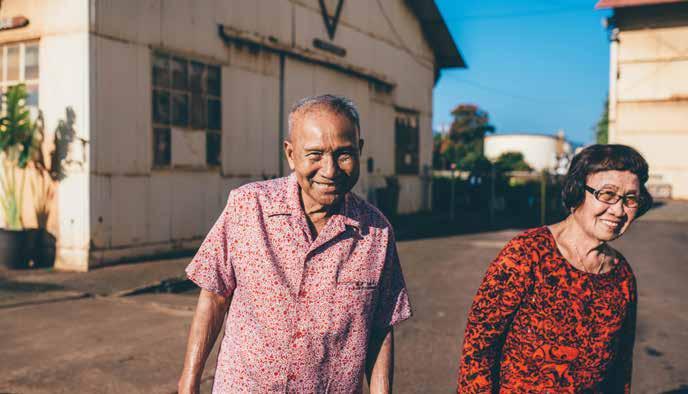
didn t like that so we started a nion. his union was a local chapter of the International Longshore and Warehouse Union, which represented workers in sugar and pineapple, as well as longshoreman and dockworkers. In 1952, all locales of ILWU joined forces. hen was in the nion had a high education [as a tradesman], so they gave me the hard job. I declined because it was hard to be a tro bleshooter rice e plains. Eventually though, he was convinced, and accepted both the role and its accompanying responsibilities. He became a union officer and began meeting with management and traveling to other plantations to fight the inequalities of the plantation system. By the 1950s, the ILWU had successfully instituted a 40-hour workweek, industry-wide medical care, sick leave, and paid vacations. Wages increased, and Erice is now proud to say that he was able to send all three of his children to college. always remind my kids it is important to study. Thanks to God, all three of them got an education. I’m really happy with that the sakada says smiling.
Nearly 30 years after retiring, Erice’s face still lights up when he talks about plantation life. liked the sense of comm nity. he company pro ided all what we needed says Erice, who recalls especially enjoying plantation-organized volleyball, baseball,
and basketball games for the workers every Sunday. His wife, Maring Erice—a quiet Filipina he met while on vacation to the Philippines, and brought back with him to O‘ahu years ago—pokes him in the back and interjects in Ilocano as he repeats himself. For decades, the close-knit community of Filipino sakadas lived in the ranch-style plantation houses alongside other Japanese, Chinese, and Spanish workers. The colaborers and neighbors often relied on each other to provide what the company did not, from sharing resources to celebrating special events. Found on the Erices’ back patio are long communal tables and a pig-preparation station, remnants of the old plantation days that the family still uses for hosting community get-togethers. Today, they are covered in bottles, the telltale signs of last night’s successful festivities. After 70 years in the neighborhood, the Erice house is still the center of the party.
After showing me his old stomping grounds at the Waialua Sugar Mill, Erice is off to his daily hour-long walk to the park. Or to drive his wife to church. Or to meet up with the surviving sakadas at the McDonalds in Hale‘iwa. Because for Cipriano Erice, life is still full.
Despite the arduous labor that Cipriano Erice faced on Hawai‘i’s sugar fields, his face still lights up when he talks about plantation life in Waialua, where he and his wife, Maring, have lived for more than half a century.
Cipriano Erice is the subject of A Sakada Story , the first of a three-part documentary series by O‘ahu-raised, Filipino-American filmmaker Maribel Apuya that highlights the history of Filipino culture in Hawai‘i. For more information, visit thesakadaseries.com.
22 | FLUXHAWAII.COM

In the Mom ent
The son of a Turkish newspaperman, Omer Kursat captures scenes both forgotten and at the fore.
TEXT BY KELLI GRATZ
PORTRAIT IMAGE BY JOHN
HOOK
Photographer and publisher Omer Kursat drinks a celebratory afternoon glass of raki in a bar in Honol l s hinatown. t is rkey s national drink he says raising his small t mbler. hen rsat frst came to Hawai i in hinatown was not where one went for an imported apéritif. Years later, there are now several spots in the neighborhood to sip such an anisescented concoction, perfect for toasting a holiday, commiserating a breakup, or in Kursat’s case, celebrating the opening of an art show and the release of a new book. aki is meant to entice con ersation he says. hen tra el back to rkey to isit with some friends and drink raki the con ersation always gets really e cited. t a stif proof it s also helping rsat get o er a cold.
There is something lively about Kursat, messy and warm. His defined, well-groomed mustache bobs as he speaks, and his hands pantomime his enthusiasm. It might be the raki b t rsat is ali e in con ersation. y whole life ne er e er tho ght of myself as an immigrant he says. t recently with e erything that s been going on in the news kept thinking about how my father was originally from Crete and then moved to Turkey, so with that in mind reali e now was an immigrant before was e en born. rsat mo ed to the United States to attend the University of Southern California, where he graduated with a bachelor’s degree in computer science, and soon after, got hired as a software programmer at a bank. He worked there for eight years before coming to live in Hawai‘i with his wife, Dee. The co ple rented ee s sister s ho se in aim nalo and ha e been li ing there e er since. find myself c lt rally displaced sometimes he says. m not in rkey not in rete. m not ati e Hawaiian. o who am st consider myself an island boy.
Some of these questions of island identity are answered via Kursat’s widescreen photos. As a photographer, he is interested in living life in the present, capturing unexpected moments through the rotating-lens of his panoramic camera. Many of Kursat’s works illustrate the beauty of spontaneity—the candidness of things—including his first book, Over the Pali, 2 a.m., No Pork which capt res hinatown s cl b and arts scene from to . like the bl rry or the f y images low sh tter speeds where yo can barely make o t things rsat says. sing a Cold War-era, Russian-made, all-metal Horizont camera that he’s had since his teenage days in Turkey, Kursat shoots the complexity of a party scene, including the unfolding dramas in the backgro nd. he scope of the images adds a sense of grande r like a still from a mo ie a cinemascope or something he describes. was always a part of the scene people didn t really know was taking their pict re says rsat whose wide angle lens camera allows him to shoot without pointing the camera directly at his subjects. The off-camera gaze adds to
“I find myself culturally displaced sometimes,” says Omer Kursat, whose photographs help to answer questions of his identity.
“I’m not in Turkey, not in Crete. I’m not Native Hawaiian. So, who am I? I just consider myself an island boy.”
24 | FLUXHAWAII.COM
FLUX PHILES | ART |
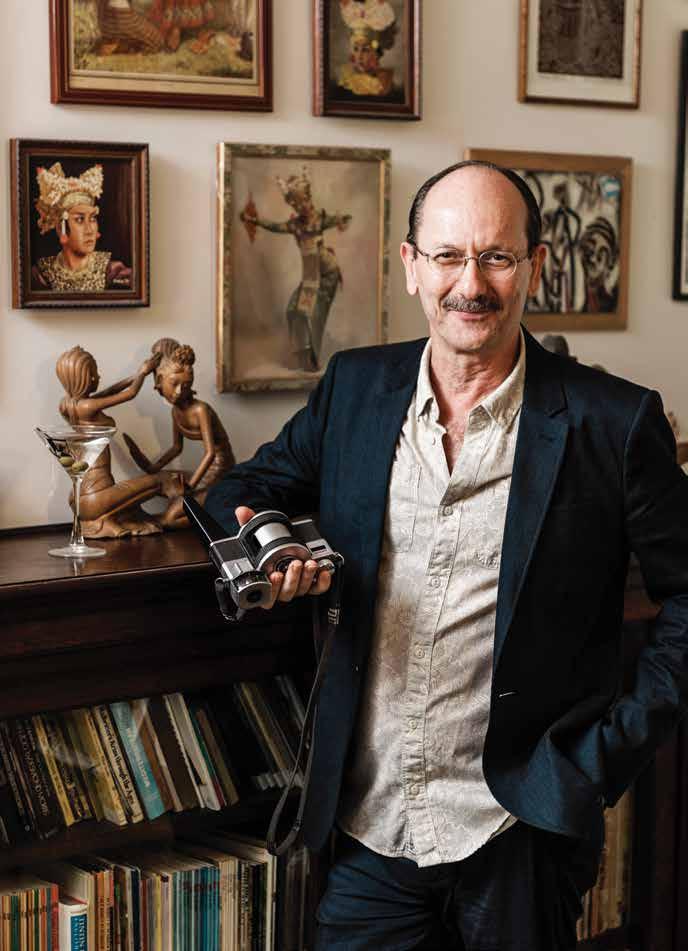
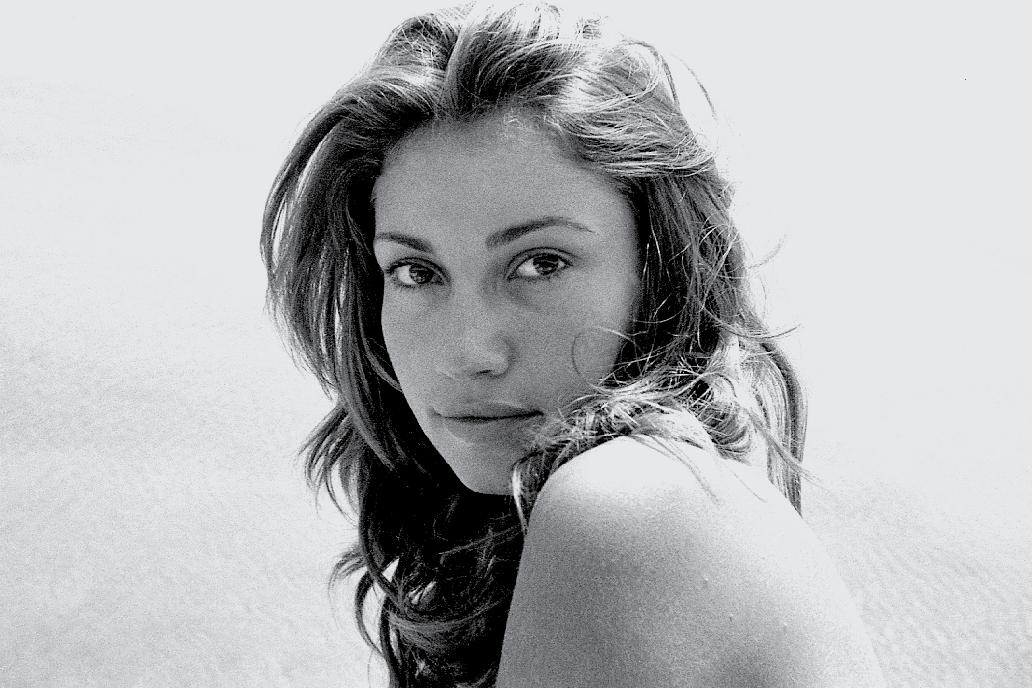
the effect and narrative, elevating the oncederided genre of party photos to legitimate art. e always lo ed taking pict res don t know why. Maybe it’s sort of like a validation of o r e istence at that moment he says.
This preoccupation with setting moments on paper also reveals itself through Kursat’s publishing company, Deuxmers, through which he has produced seven publications, including poetry and photography compilations. The photographer is currently working on a second compilation of images salvaged from the collections of Peggy Ferris, a photographer and journalist who worked in Honolulu after World War II, as well as a collection of translated poems by an avantgarde Turkish literature collective known as The Second New.
Kursat’s work as a populist photographer and publisher is a natural result of his being the son of a journalist. Ege Ekspres (Aegean Express in English) was the name of Kursat’s father’s newspaper, which he started in a dangerous time. Originally from Crete, the Kursat family was forced to move to Turkey in the early 1920s as a result of the population exchange between Greece and Turkey during
the Turkish War of Independence. The partitioning of the Ottoman Empire forced emigration between the two evolving nations ia staggering iolence. y father was a very free-thinking, liberal person. It even landed him in jail for six months for writing a column that criticized the political party that was in power at the time rsat reflects. He is the reason I am the way I am. His influence shaped my perspecti e in life. Again, it might be the raki talking, but Kursat is a continuous stream of stories, jovial anecdotes of family adventures and North Shore weekends. In 10 minutes, he can recite tales of his first days in Hawai‘i, the sting of Manal Bay sea urchins at his family’s summerhouse in Turkey, rumors of Saint Nicholas; he even broaches the subject of exgirlfriends—and he’s just getting started. For a man that just celebrated his 60th birthday, he’s filled with as much energy as someone a quarter of his age. He carries the wisdom of someone who has taken long journeys across oceans, only to return to the place he now calls home.
Kursat remains preoccupied with capturing moments, like this one of carefree Nevra, a friend he photographed in 1970s Turkey whose image is one of 52 self-processed film photos in Kursat’s book Young Turks
For more information on Kursat and Deuxmers, visit omerkursat.com and deuxmers.com.
26 | FLUXHAWAII.COM
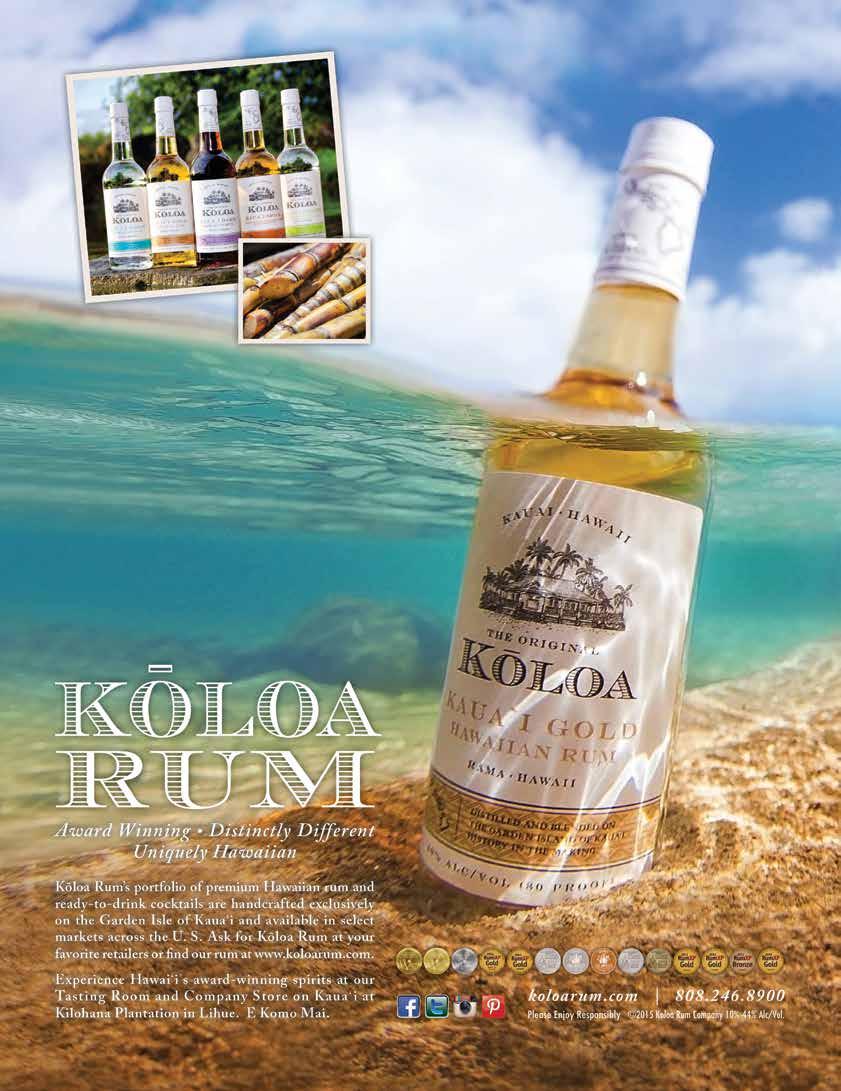
Morris Makes Contact
The descendent of an English merchant and Hawaiian royalty finds inspiration in fluidity.
TEXT BY CHRISTA HESTER
IMAGE BY JOHN HOOK
Striding through the rainforest of upper Nu‘uanu, artist and photographer Linny Morris weaves past trees and down a sloping hill until she reaches a hidden waterfall of Nu‘uanu Stream. Her fingers swipe to unlock her phone and record the minute details that interest her: sparkling plumes of mist that rise from the waterfall and dissipate in the sunlight, specks of bubbles traveling over the water’s surface, floating fishnet patterns knit together by water and light.
Morris’ deep relationship with water was the impetus for her installation in Contact: Foreign and Familiar, an exhibition held in April at the Honolulu Museum of Art School that focused on c lt ral e change and migratory mo ements. y piece he onse ence of onfl ence was a looped ideo of freshwater and saltwater footage she says. orris who makes a li ing as a photographer specializing in editorial and architectural work and has a degree from Parsons School of Design, projected the video onto the ground and enclosed it in a varnished wooden box topped with a railing. The idea came to her while on a cruise in Alaska, during which she reg larly rested on the ship s railing while ga ing at the water. was mesmeri ed looking down at the water with the endlessly peeling white wake and the shifting reflections of sky and distant mo ntains she writes in her artist s statement for the show.
kept thinking how all the people come from ha e had this same e perience says orris whose family genealogy was passed down over years of oral tradition. Her paternal greatgreat-great grandfather, English captain Samuel Dowsett, sailed to Hawai‘i on the Wellington in 1828. Her paternal great grandmother, Martha Kahailani Holmes Dowsett, was the daughter of Kapelakapuokakae Kahalelaau, a pure Hawaiian chiefess whose Polynesian ancestors sailed to the islands centuries before. While these forebears shared neither skin color nor religion, they all knew what it was like to peer down into the deep Pacific waters.
It is this connection to water that allows Morris to bring her historically divisive Hawaiian, missionary and ropean blood together flowing in her eins in peace. o me water b ilds a bridge between these astly different peoples who were often di ided by history orris says. hey left e erything they knew the bea tif l land and life s staining freshwater to cross the ocean and find that same freshwater here in Hawai‘i. I can only imagine the fears they had crossing that great expanse, and how comforting it must have been to stare at the water peeling away from the essel.
Morris grew up feeling slightly removed from Hawaiian culture because of her haole looks and lack of cultural knowledge, but she is quickly finding her voice amongst other local artists such as Bernice Akamine, Kaui Chun, Joshua Lake, and Jerry Vasconcellos, whose works were all featured in Contact. his e hibit made me estion whether was Hawaiian enough to stand with these other artists, who have always sort of intimidated me with their c lt ral practice and correctness she says. ometimes feel g ilty for not ha ing learned o r language or dancing hula or knowing more about our history, but I’m at peace knowing that I’m honoring my Hawaiian ancestors through small rituals of daily gratitude and by observing, nderstanding and creating.
For photographer Linny Morris, water has come to represent the shared connection of her Polynesian and European ancestors, who crossed unknown ocean expanses to reach Hawai‘i’s shores.
To see more of Morris’ work, visit linnymorris.com.
28 | FLUXHAWAII.COM
FLUX PHILES | ART |


F ight or F l ight
By migration and accident, birds arrived in the Hawaiian-Emperor archipelago over the course of several millennia. They evolved to create one of the most unique ecosystems on the planet. Since that time, most of Hawai‘i’s endemic birds have not survived humanity’s time on the islands. Now, at 6,500 feet above sea level, where cumulus clouds form, bird scientists are exploring sophisticated genetic biology and continuing evolution, which may save both bird and man from the effects of a warming world.
TEXT BY SONNY GANADEN
IMAGES BY JOHN HOOK
FLUX FEATURE


By the time Polynesians arrived in Hawai‘i some time after 300 CE, the islands were home to at least 110 separate species of birds found nowhere else on Earth. There were all sorts of creatures roaming the forest, like the great a i crake a ightless rail that h ng out in the understory; and the moa-nalo, an earthbound browser twice the size of a chicken, which must have been delicious considering its extinction coincided with the Polynesians’ arrival. Over centuries, Hawaiians named nearly every forest bird, as well as the numerous migratory birds that frequented the islands en route to faraway shores.
Of those 110 known species, only 48 still exist today, and many are critically endangered. The demise of endemic birds escalated in proportion to the migration of human settlement. As dry lowland forests were cut and turned to farmland by Native Hawaiians, and later made into towns, ranches, sugar fields, and airports by waves of Europeans, Americans, and immigrant laborers, the habitat for native birds was confined to what remained of the islands’ wooded peaks. here are reports from the 18th century of bird collectors saying, ‘I saw them in this kind of tree says hris arren avian biologist of Maui Forest Bird Recovery ro ect. f co rse they wrote that down after they shot them he laments.
Since those grim days, scientists, volunteers, landowners, and the state and federal governments have made significant efforts to save both Hawai‘i’s endemic bird population and the remaining forests they inhabit. This process has begun to utilize the cutting edge of genomic biology, what is referred to as the genomic revolution. In the 21st century, supercomputers have exponentially reduced the cost of mapping genomes. It took an international scientific community nearly two decades and $4 billion dollars to map the human genome, which was accomplished in 2003. With new technology, an individual animal, including human or bird, can have its genome mapped for approximately $100. There are implications for human welfare, as historically the expansion of biological science has led to discoveries and approaches that no one could have predicted: Moldy bread led to the development of penicillin, heating milk to the discovery of pasteurization. Saving an obscure
population of colorful, highly specialized forest birds in the middle of the Pacific Ocean just may lead to human survival in an unpredictably warming world.
LAST BIRDS OF THE FOREST
The sun has risen, but it’s still wet and dark as we drive in the shadow of the great mountain to Kula Forest Reserve on the leeward slope of Haleakal on a i. s part of a multi-step project to restore and maintain what is left of the original forest of Hawai‘i, and also to study health of Maui’s endemic forest bird population, Maui Bird Recovery Project is catching, studying, banding, and releasing birds. Led by Chris Warren, the day’s team consists of Erica Jernaill, a King Kekaulike High School senior adept at navigating the forest, field associate Bob Taylor, and Loren Cassin Sackett, Ph.D., an evolutionary biologist.
The ascent up the mountain provides a view of Maui’s vast interior valley, from ah l i to the north hei to the so th and the West Maui Mountains in the distance. ass me it happens e ent ally b t ha e you gotten used to the beauty of this place ackett asks arren. He responds as a scientist on an island where half of the pop lation is on acation his place is beautiful the way other places are. I just wish it was better preserved. … But seeing invasive species everywhere makes it less so for me. But I’m learning to take a step back, to see the forest thro gh the trees.
Chris Warren is a man of the feather. The two tattoos on his right forearm, which look like the readings of a seismic chart, are bird calls: one, of a warbler from Texas, where Warren got his master ’s degree, the other, of a Maui parrotbill, or kiwikiu, a pudgy honeycreeper with the business end of a giant parrot on its face. To catch birds, Warren employs a variety of techniques that would be familiar to the hahai manu, or specialized bird catchers, who once traversed these same forests. As a sort of modern hahai manu, Warren needs to think like a bird. After setting up their banding station, he finds several spots in narrow clearings of canopy that birds would need to cross, finding the path of least resistance from point to point.
The crew sets up wispy nylon nets in these aerial paths that forest birds might

The birds are fnding ways to s r i e fnding things to eat other than hi a nectar and discovering places to nest other than in native trees.
Maui Bird Recovery Project is studying an obscure population of birds in the Kula Forest Reserve, including the endangered ‘i‘iwi.
32 | FLUXHAWAII.COM
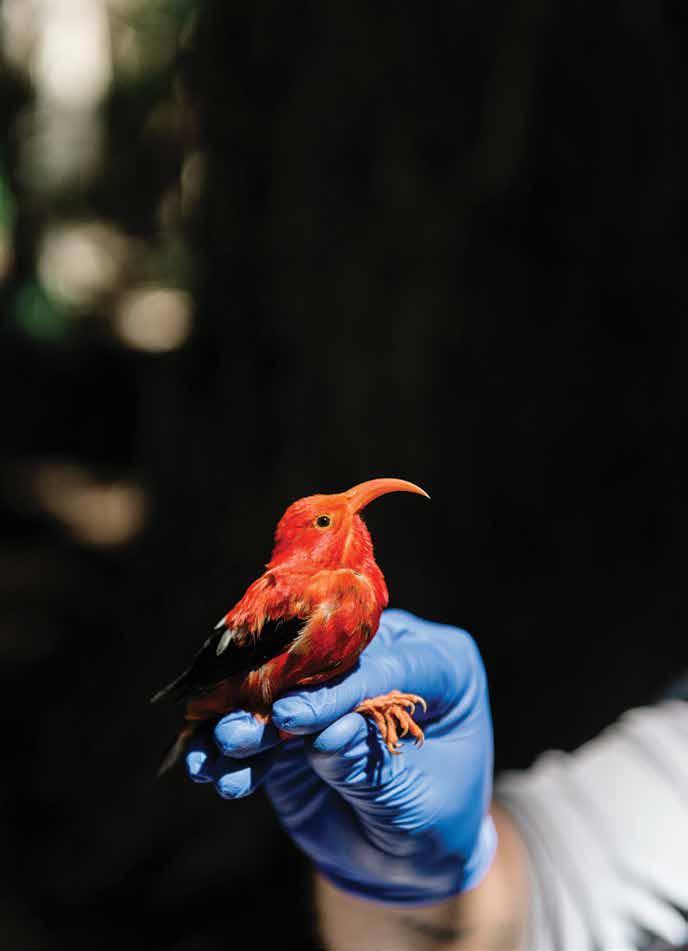
follow. Stealthy as spiderwebs, the nets are suspended between two collapsible fishing pole rods. Some stretch 12 meters across. Unsuspecting birds are caught, gently decelerated, and sent tumbling into a cradle of nylon. As birds can be stuck in dangerous positions, nets are checked at least every 30 minutes, and are set in a perimeter around the temporary site that resembles a makeshift field hospital. When one is found, it requires deft hands to gather it in a soft cotton bag, where the bird flutters in capti ity. o acti ely catch a bird re ires a bit more effort: Warren sets up two speakers on either side of a net attached to his iPod, and plays a trick. The catch begins when a call sounds from one speaker, followed by the same call from the second. To a bird, it’s as if an invisible rival or mate has suddenly appeared and then flown to a nearby tree. The situation must be investigated. Warren cues the speakers as an ‘apapane, then an ‘amakihi, alight on a nearby branch before fluttering away. The ‘amakihi looks like a flying scoop of pistachio ice cream with a beak.
The Kula Forest Reserve is mostly nonnative, consisting of redwood and eucalyptus giants that were planted a century ago in an attempt to slow massive erosion caused by the harvesting of sandalwood and clear-cutting of the forest, and the ranching industry that followed. The eucalyptus was introduced for its ability to grow quickly. Unfortunately, the trees are brittle in tropical storms, and so every few years, the mountainside’s trails become an accumulated mess of dry, flammable tinder. Fires happen more than Warren would hope, and the smell of wood smoke from a fire that many think was maliciously set just a few miles away lingers in the air. his place has been f el loading since the last fire in arren says. Above 4,000 feet, it’s difficult to put a fire like that out with just helicopters. The trucks can’t get p here. hat st terrifies me.
Despite his fears, the forest maintains the aura of a cathedral. Mist descends through the dappled light where the road ends at Polipoli State Park. At dawn, birds can be heard clamoring and echoing through the fallen tree trunks. In 2011, several stateowned tracts of land on Maui were given greater habitat protection, paving the way for restoration. Even in this nearly entirely nonendemic forest, the birds are finding ways
to survive, encountering things to eat other than hi a nectar and disco ering places to nest other than in native trees. The Maui Forest Bird Recovery Project is one of several state and private organizations working to systematically, piece by piece and fence by fence, replant, protect, and manage the forest. At some point, through long-term planning and short-term funding, the forest will form a complete ring of functional habitat—a crown of green on Haleakal .
THE VAMPIRIC VECTOR
Evolved in the isolation of the vast Pacific Ocean, Hawai‘i’s forest birds are classic examples of adaptive radiation, or the diversification of one species into a multitude of new forms, like the Galapagos finches Charles Darwin wrote about at the outset of our understanding of genetics. The HawaiianEmperor seamount chain rose from the sea millions of years ago, where life evolved without humans and everything that humans brought along with them that has decimated birds: deforestation, roads, cattle, pigs, cats, and mosquitoes, which arrived in the islands in 1826.
In the 1930s, Hawai‘i’s endemic birds were ravaged by avian pox and avian malaria, both of which are transmitted by mosquitoes. These diseases are still here today. Because mosquitoes breed and thrive in tropical temperatures above 80 degrees, endemic birds are thought to be safe year-round at cooler ele ations appro imately abo e the mos ito line which is between to feet above sea level. As temperatures drop in the winter, birds can migrate to lower elevations nearer to 2,000 feet. But for the last several years, with temperatures rising around the world due to climate change, the habitat for mosquitoes has grown with the heat, while the habitat for native birds has dwindled. Equal-opportunity destroyers, mosquitoes transmit pathogens to nearly every vertebrate. For humans, mosquito-borne diseases, including malaria, dengue, and chikungunya, cause an estimated 1 million deaths globally every year. The bugs have been far more apocalyptic for island birds: Since its introduction, avian malaria is blamed for the extinction of many of Hawai‘i’s honeycreeper species (over half of which are now extinct), and also wiped out entire families of birds.

The bugs have been far more apocalyptic for island birds: Since its introduction, avian malaria has caused the extinction of entire families of birds.
Similar to the Hawai‘i ‘amakihi, the ‘alauahio, or Maui creeper, has been threatened by avian malaria at low elevations where mosquitoes thrive.

34 | FLUXHAWAII.COM

Most honeycreeper species have gone completely extinct at low elevations.
There are global initiatives underway to use genetic science to eradicate mos itoes or at least their efects. nfort nately the pests are hardy, resistant to chemical controls and the predation of other insects birds and fsh. onetheless scientists ha e performed s ccessf l feld tests in which local mosquito populations have been regionally wiped out, at least temporarily. The solution, it seems, is hampering the insects’ reproductive biology rather than eliminating larval or adult insects. Oxitec, a British biotechnology company, has experimented with the release of millions of genetically modifed mos itoes in feld tests in the ayman slands alaysia anama and ra il. he genetically modifed mosquitos throw a glitch into the life cycle of Aedes aegypti, or the yellow fever mosquito. Here is how it plays out: Male mosquitoes are harmless nectar-eaters, while female mosquitoes carrying eggs are the ones that bite. Oxitec introd ces males that are genetically modifed so that their ofspring cannot reach ad lthood. hen these modifed males mate with wild females the ofspring die before they can repeat the cycle. However, since tests have not been conducted on isolated islands, wild mosquitoes have quickly replaced itec s genetically modifed ones th s hampering their experiments. This hasn’t prevented Brazil, in the throes of Zika virus outbreak, to give the company the approval to commercially introd ce their genetically modifed mos itoes.
In Hawai‘i, one of the most remote island chains in the world, the ecology evolved without the little bastards. Because of this isolation, it is scientifically feasible to eradicate the problem entirely while continuing to monitor newly introduced populations. But any possible test would likely be met with public outcry here. Hawai‘i’s electorate has become wary of genetically modified anything, since multinational corporate farms have used the valley lands of Maui’s former sugar fields as the test site of genetically modified crops over the last several decades, including staples like soy, corn, and rice. With genetically modified mosquitos, there remains the possibility, which Oxitec refutes, of developing allergic reactions or virulent diseases from the bites (while Oxitec tries to introduce only males, a limited number of genetically modified females have been mixed in the released batches).



If the experiment works, it would have profound effects on the health of the humans and birds that reside on the islands. I am not the only person to have a fictitious, romantic conception of pre-contact Hawai‘i, rooted solely in the lack of b g bites. magine For centuries, an island surf session could be followed by an open-air nap without a mosquito bite that woke one from the deepest sleep.
SONG OF MAN AND BIRD
en so far arren says back at the forest counting the calls of ‘i‘iwi without ever act ally seeing one. ocali ations can be songs, say for mating or fighting, or calls, ways to check in a sort of declaration of e istence he explains as bees whirr overhead like an old air conditioner.
A hundred meters away from a clearing where the team holds camp, Warren plays bird songs through speakers connected to his iPod, attempting to catch an elusive study s b ect. almost had a H o er he whispers into a walkie-talkie. Avian biologists refer to birds by four-letter acronyms; a H is a Hawai i amakihi. e ca ght an o er here aylor responds referring to the only bird whose acronym is its name: the ‘i‘iwi, or scarlet Hawaiian honeycreeper, the iconic animal of the islands’ remaining forests—an exciting catch that sends us rushing back to camp.
Emerging from a cloth bag held by Taylor, the ‘i‘iwi is a showstopper, demanding attention with its color, which has the arresting capacity of a stoplight. Warren holds the bird in the palm of his hand as he prepares for the banding procedure, then using the gentlest of pressure between his middle and ring finger, he bands its legs, admiring its plumage as the bird whistles and chirps in indignation. The size of a man’s fist, an ‘i‘iwi is small and majestic. Knowing nothing of its cultural significance, the bold Hawaiian forest bird’s color and vocalization make it an obvious candidate as a spiritual being—the avian intermediary between man and the heavens. In fact, in Western context, angels are nearly always depicted with wings. n Hawai i many forest birds were a m k a including the fiery ‘i‘iwi, deified ancestors taking animal form.
ome re ered a m k a are gone fore er. he ah and Hawai i sland or yellow tufted honeyeater, were gorgeous coal-black songbirds with neon-yellow shoulder tufts and long, black, white-tipped tail feathers. feathers were caref lly pl cked by hahai manu, an essential part of the pre-Western economy in the islands, collected as a form of taxation and used by the elite to construct elaborate standards and symbols of religious and political importance. As part of the moho gen s specifc to Hawai i the last sang in 1987 on Kaua‘i, and has now been declared e tinct. long with the the mamo which provided the ali‘i’s black feathering, is also extinct. On O‘ahu, ‘i‘iwi are also thought to be gone. Every few years, birdwatchers still note a few which co ld be ad lts who ew from other islands. Kaua‘i is similarly barren of the birds. But today, the ‘i‘iwi being expertly handled here in the Kula Forest Reserve is very much alive. It is a boisterous, loud, mid-ranking bully among honeycreepers, known for chasing its genetic cousins around flowering hi a trees and pecking at ri als. Honeycreepers loudly proclaim their arrival at food and mating sites in the third person, so Hawaiians named the ‘i‘iwi after the bird itself as an onomatopoeia, as they did with the ‘elepaio. I can hear it now, between whistles and s eaks yelling iwi iwi the a ian e i alent of saying m enny owers nd am ery pset his g y is healthy. He co ld be between and years old arren says of the i iwi as Jernaill notes the observation. The bird’s hooked beak looks like it was modeled after the orange of candy corn. Over the course of the day, the group catches several birds: a few Maui ‘alauahio, which prove to be especially gullible to the double-speaker trick, two ‘i‘iwi, and a few Japanese white-eye, or mejiro, part of a population pet owners began setting free in the wild starting in 1929 that filled the niche left vacant by extinct species. Warren explains how to release a small bird: gently grasp its neck from behind with your pointer and middle finger while cradling its legs with your other hand. Then, open your hands. Surprisingly, some endemic birds are recovering despite the prevalence of mosquitoes. Sackett is attempting to determine how this survival is happening. Her previous work, studying prairie dogs,

The bold Hawaiian forest bird is an obvious candidate for a spiritual being— an avian intermediary between man and the heavens.
The
38 | FLUXHAWAII.COM
red-billed leiothrix is found in the Kula Forest Reserve.

attempted to understand the animal’s resistance to bubonic plague via the lens of genetics. In recent years, researchers and birdwatchers have seen more ‘apapane and ‘amakihi in lower elevations on Maui and Hawai‘i Island. These species appear to have become moderately resistant to avian malaria. How the heck are they doing that ackett asks incred lo sly as we wait to catch birds. f that estion can be answered, it would help the other birds, which share a genetic ancestor. ackett has two theories ne that certain members of the pop lation preg late meaning that the cells of these birds’ immune systems react to the pathogen, allowing them to survive. Two, that there is a recent mutation that makes the pathogen inert, or in other words, the bird has evolved. The possibility of a genetic basis for resistance—of evolution—is exciting, as it has occurred in the relatively short time of approximately 30 generations of birds. Determining these pathways to survival in a small population can lead to developments for other species. From the blood samples collected today, Sackett will determine the genetic signatures of the birds and if there are any traces of avian malaria, as well as their mechanisms for survival. The data s ggests ca tio s optimism that the ʻapapane and ʻamakihi have adapted, or evolved, to resist the pathogen. kay this g y s ready to go arren says smoothing the nape of the ‘i‘iwi’s ruffled feathers before handing it to Jernaill. Clasping the small bird with extended arms while making her way to a clearing a few meters away, Jernaill proceeds carefully, as if walking down the aisle of a cathedral holding a chalice after mass. She stops at the clearing and opens her hands. The ‘i‘iwi takes off toward the canopy, whistling and declaring its name while streaking skyward, then disappears into the mist.

40 | FLUXHAWAII.COM


Foreign Ambassador
Geographer Doug Herman has traveled throughout Hawai‘i, researches and writes about the canoe as the islands’ most potent cultural metaphor, creates world-class exhibits about its people, and speaks Hawaiian fluently. He does all of this from more than 7,600 miles away in Baltimore, Maryland.
TEXT BY TIMOTHY A. SCHULER
IMAGES BY BRYCE JOHNSON
Despite being non-native himself, Doug Herman, senior geographer at the Smithsonian Institute National Museum of the American Indian, has become the ambassador for Native Hawaiian communities in the nation’s capital, even as the role of outsiders continues to be debated.

FLUX FEATURE
42 | FLUXHAWAII.COM


Do g Herman is ner o s. n f e days, he will sail from Honolulu Harbor to Hilo Bay on a three-day journey aboard the Hikianalia, the sister vessel of the famed voyaging canoe, Hōkūle‘a. The 56-year-old geographer has been fascinated by Polynesian voyaging since he arrived to teach at the University of Hawai‘i at noa in st eight years after members of the Polynesian Voyaging Society sailed Hōkūle‘a from Hawai‘i to Tahiti, thus disproving previously held theories of Polynesian settlement. But the Hikianalia voyage will be Herman s frst on the open ocean. ha e been giving talks on traditional navigation [for years], but I have no real, physical knowledge of even being on the boat away from the dock says Herman who sits cross legged on a rattan sofa in a cozy holiday rental on Kaua‘i, the island on which he’s chosen to conduct interviews for a separate research project. want to be able to translate all this book knowledge and embody it.
Herman is the senior geographer at the Smithsonian Institute National Museum of the American Indian in Washington, D.C. He is also the creator of acifc orlds an indigenous geography project that works to preserve traditional cultural knowledge thro gho t the acifc slands and package it into a place-based curriculum for educators.
Although he lives in Baltimore, Maryland, Herman’s research has, for the past 25 years, foc sed e cl si ely on Hawai i and the acifc Islands. Beginning in 2009, he spent three years researching traditional canoe-making for a major exhibition for the Smithsonian titled Aloha Aina: Hawaii, the Canoe, and the World, conducting more than 100 interviews with contemporary navigators, carvers, artisans, featherworkers, society leaders, activists, and scholars. Around the same time, he built his own 16-foot outrigger canoe (based on plans by famed multihull boat designer James Wharram) and chronicled the experience for the Smithsonian’s blog. For centuries in Hawai‘i, kahuna kalai wa‘a, or master canoe builders, were talented elites with sacred knowledge of how to turn the natural arbors of the land into sleek, durable vessels of the sea. ferings were made at the base of the tree to the gods, with prayers, a small black pig cocon t red fsh and awa a ceremonial be erage more commonly known as ka a Herman wrote on his blog in ne . or a
bigger and more important canoe for a noted chief a h man sacrifce might be deemed necessary.
Over the years, Herman has become an no cial ambassador of Hawai i writing for a national audience about such things as the cultural implications of building a new telescope on Mauna Kea on the Big Island, or the Polynesians’ place among history’s greatest na igators. olynesian migration resides among the greatest single human ad ent res of all time Herman wrote for the online edition of Smithsonian Magazine. Here were small island peoples sing stone tools, crafting rope from coconut husks and stitching pandanus leaves into sails to build an ocean-going craft that could journey 2,500 miles and back again.
Although Hikianalia’s voyage from O‘ahu to Hilo should be a cakewalk compared to those early voyages as the double-hulled canoe was outfitted with engines and GPS Herman feels a slight trepidation at the prospect of crossing the len ih h hannel a mile strait between Maui and the Big Island that is generally regarded as the most dangerous channel in the Hawaiian slands. hen told the Polynesian Voyaging Society guys that that’s the leg I wanted to do, they said, ‘You’re doing that one? You’re gonna need some gear Herman recalls. he channel s name ro ghly translated means great billows smashing and winds in this stretch of the Pacific, which are funneled between the twin peaks of a na ea and Haleakal on Maui, can reach 50 miles an hour, with swells topping 40 feet. It’s not just the danger that weighs on Herman’s mind. The trip is something of a test for the scholar, whose ultimate goal is to secure a spot on a voyaging leg of the Hōkūle‘a, currently in the midst of a oyage aro nd the world. ha e to pro e that I can survive on a canoe before they’re gonna p t me on a real oyage he e plains.
For now, Herman is trying to focus his mind here in H ena on a a i s north shore. The community is one of seven sites Herman has documented as part of Pacific Worlds, which spun out of a program launched by the Smithsonian in 1999 to help bridge computer technology and traditional cultural beliefs and practices—two things that, at the time, seemed diametrically opposed in many native communities in the United States. Herman initially worked with a Hopi community in

ha e been giving talks on traditional navigation, but I want to be able to translate all this book knowledge and embody it.
Herman’s research has focused exclusively on Hawai‘i and the Pacific Islands for the past 25 years.
44 | FLUXHAWAII.COM

Arizona on the project but quickly saw its potential for the Pacific Islands. He launched Pacific Worlds in 2000, weaving together geographic research with myths and oral histories told to him by elders and community members.
Voyaging, of course, played an important role in the curriculum, which has been adopted by institutions throughout the acifc from elementary schools to colleges. The topic of Polynesian migration was one of the frst lessons st dents learned and discussed. Herman hoped the project would inspire others to follow in acifc orlds footsteps, which for a while seemed likely to happen. t was all going really well ntil No Child Left Behind came along and wiped o t all the f nding for c lt ral ed cation he remembers. Years later, Polynesian canoe culture is woven into schools throughout Hawai‘i, and Herman aims to reboot his project with an added emphasis on climate change. here s that Hawaiian pro erb hewa‘a he moku, he moku hewa‘a, ‘the canoe is an island the island is a canoe he otes. limate change is reminding s that the world is an island.
Hawai i. didn t know anything abo t Hawai i b t was really interested in sia he says. Reading it, he found a place where he might ft in b t his application wasn t accepted. he ni ersity of Hawai i at noa howe er ga e him a teaching assistantship. Herman used what he learned to write about the similarities between Buddhist principles and the cultural practices of many acifc slanders b t in 1984, he had his sights set on Asia, envisioning a career in economic development or urban planning in India or China. For Herman, Hawai‘i was just a stopover.
As early as he can remember, Herman has been drawn to cultures other than his own. He grew up in Washington, D.C., in a home flled with sian art and stories of his father s time in Japan, where the longtime moderator of Face the Nation lived while covering the Korean War as a CBS war correspondent. Herman inherited his father’s fascination with all things abroad, and became even more interested after learning about Eastern religions in school. At Dartmouth College, his father’s alma mater, Herman majored in religion and spent two months at an orthodox Chinese Zen monastery in Northern California. There, waking up at 3:30 a.m. and eating just one meal a day, spiritual practice became more than an academic pursuit. It would transform Herman’s life. When he returned to Dartmouth, what had already seemed foreign now seemed totally alien. was conf sed by the al es of merican culture. It wasn’t making sense to me, partic larly at this preppy college he recalls. Nearing graduation, Herman came across a poster advertising the East-West Center in
Two years into his master’s degree, however, the adventurous geographer went on a solohiking trip along a a i s ali oast to the remote alala alley marking his frst encounter with a wilder, more pristine Hawai‘i. He recalls reaching a high point in the valley and being dwarfed by its cathedral like clifs where he had a second epiphany. knew, as I looked out from a high point in the middle of the valley, that the closest landfall in that direction was [Russia’s] Kamchatka enins la tho sands of miles away he says. hinking abo t the frst olynesians to set foot in Hawai‘i, and what it would have been like to cross the ocean in a canoe, he gained a new respect for their way of life. He returned to Honol l and went straight to the o ce of Abraham Pi‘ianai‘a, the director of UH’s Hawaiian Studies program at the time. After less than an hour, Asia was a distant memory. For Herman, Hawai‘i was now the focus.
Like so many other migratory creatures, Herman eventually returned home. In 2007, he oined the staf at the ational se m of the American Indian, writing scholarly articles, editing a variety of books, and occasionally teaching museumgoers about the materials used in ancient Polynesian voyaging. But the fact of Herman’s ancestry—that he isn’t American Indian or Native Hawaiian himself— has created con ict. y m se m does not recognize me as an ambassador of Hawai‘i beca se m not nati e Herman says. hen he recently suggested that he demonstrate traditional Hawaiian canoe carving at a festival devoted to Hawaiian culture, the Smithsonian’s organi ers dem rred. hen p sh came to sho e it was beca se m not Hawaiian according to Herman.
The biggest blow came when, for reasons that were never explained to him, the Aloha Aina exhibition—which he had

art of it
and I’ve only realized this in recent years— is that I don’t really identify with white American culture. I ne er ha e.
H ā‘ena on Kaua‘i’s north shore is one of seven sites Herman has documented as part of his Pacific Worlds project, which he hopes can bridge computer technology and traditional cultural beliefs and practices.
46 | FLUXHAWAII.COM

been spearheading for three years—was ne pectedly canceled. t st s ddenly phwoot! disappeared off the sched le Herman recalls. (The decision may have stemmed from a growing desire in Native Hawaiian communities to be treated as an independent nation, and to not be lumped in with the American Indian tribes of North America. Museum staff, however, did not confirm a specific reason for the exhibition’s cancellation.)
These situations have arisen with more regularity, as the role of outsiders in native and minority communities—informed by centuries of colonialism and trauma—has been debated for decades. Most recently, Black Lives Matter has brought the debate to the fore with white allies being asked to stay of the megaphone as one set of instr ctions at a Boston protest put it, and Herman has earned the trust of the community by doing just that. ch of the te t incl ded in the acifc orlds curriculum comes directly from community leaders, and Herman gives his interview subjects near total control over what ultimately is published. But he has encountered skepticism along the way. When he does, Herman often relies on his academic pedigree. n Hawaiian c lt re e erything is based on genealogy, so in certain settings, I will recite my [academic] genealogy, which is Abraham Pi‘inai‘a, Rubellite Kawena Johnson, Puakea ogelmeier and ll do it in Hawaiian says Herman who speaks the lang age ently. n the s d ring what he calls the s per hot days of the so ereignty mo ement when Haunani-Kay Trask, an oft-quoted indigenous rights activist, was the director of the Hawaiian Studies program—Herman was more than a little aware of the color of his skin. t was a ery di c lt time to be white and particularly a white male scholar doing ati e Hawaiian st f he says. managed to y nder the radar partly beca se was learning Hawaiian. Part of it—and I’ve only realized this in recent years—is that I don’t really identify with white American culture. I never have. I’m somewhere in the middle in my sense of myself. So I just didn’t feel like [they were] talking about me. But I knew that they could be, and that that gun could be pointed at me. And that gun has been pointed at me o er the years. t only brie y.
For some, ancestry is unimportant. At a comm nity workday in H ena se eral
members of the local environmental group Hui Maka‘ainana o Makana told Herman that the comm nity is not defned by race. he comm nity they said is whoe er shows p. Few have demonstrated this attitude more powerfully—or personally—than Lynette Hi‘ilani Cruz, an anthropologist and kupuna in residence at Hawai i acifc ni ersity who adopted Herman into her family as her h nai brother. Cruz, who has been involved with the Hawaiian sovereignty movement, met Herman years ago and says she was str ck by his understanding of Hawaiian history and [his] s pport for the kind of work we were doing. Over time, their relationship deepened, and one day, Cruz proposed that he join her family. think he was taken aback by it she says. eca se that s a big deal yeah f the decision r adds t s not a head thing. t s a g t thing.
For Herman, there could be no greater symbol of acceptance. And yet he also accepts that he still may not have a place among all local scholars. hey don t need me he says. y role think is to comm nicate to the rest of the world. pecifically r says Herman is an important voice and resource in the capital. When he left Hawai‘i for Washington, D.C. she told him there was a reason for his being there. A few years ago, at least one of those reasons became clear.
In 2012, Cruz and several other activists traveled to the country’s capital to raise awareness about the 1897 Ku‘e Petition, which was uncovered by scholar Noenoe K. Silva in 1996. The petition had garnered more than 20,000 signatures from Hawaiians who opposed U.S. annexation. Among the events involved in the trip was a dramatic reenactment of a meeting between members of the Hui loha ina a gro p of women who had organized in support of Queen Lili‘uokalani. Herman helped Cruz secure a venue for the reenactment and, because he speaks Hawaiian, e en played the role of the minister. he minister was part haole so o g act ally ft the part r says with a la gh.
Today, a copy of the Ku‘e Petition is on display as part of E Mau Ke Ea: The Sovereign Hawaiian Nation , an exhibition on Hawaiian sovereignty that spun out of Herman’s work on Aloha Aina . The exhibit, which opened January 2016, will run through 2017 and will be on display when the Hōkūle‘a reaches D.C. in May 2016. In honor of its arrival, the
48 | FLUXHAWAII.COM

museum has planned a slew of special events, but Herman isn’t sure he’ll attend. He hopes to be on the canoe itself. hat s a better place for me he says.
When Herman arrives at the Marine Education Training Center in Sand Island, the Hikianalia is nowhere in sight. The crew—a mix of longtime voyagers and new initiates— has little choice but to wait. Some make last-minute supply runs. Others sleep or talk story. It’s dark by the time Hikianalia fnally arri es having been delayed by an nsched led stop in ai nae. Because of the late start, and strong winds out of the east, the canoe has to be towed all the way to Maui by the H ‘ kela a chartered fshing boat. On day two, the crew fnally sets sail and things go smoothly—until they reach the len ih h hannel. As the sun sinks behind them that second night, winds whip the water, churning out the giant black billows for which the channel is named, and causing the canoe to pitch as it crests the now 15-foot swells. Despite the technology onboard, navigators on the Hikianalia rely on the sun, stars, and waves to chart the canoe’s course. Using these methods, watch captain, Heather Nahaku Kalei, who sailed from Samoa to New Zealand on the Hōkūle‘a in 2014, realizes that the canoe has been pushed off course. The crew needs to bear northeast. t when we try to tack we can t t rn the canoe Herman recalls. The winds are too
strong. Two crewmembers also are out of commission.
ne s seasick and the other s knee had gone o t he says. o they were waking s p for half-hour shifts, between midnight and 6 a.m., to come o t and help.
The crew never reaches Hilo. That night, the captain, Ben Perkins, gives the order to tow the canoe once again, this time to the closer Big Island destination of Kawaihae, which the Hikianalia reaches without further incident. Despite the trials, Herman is not dissuaded. In fact, he feels an even greater desire to join the crew of the Hōkūle‘a, and recalls the high point of his trip, when on a particularly clear night beneath the stars, he is posted at the steering paddle. Kalei instructs him to hold the course. He looks up at the sky to find Mars glowing brighter than any star, and uses the planet as a guide, holding the canoe steady so that the planet remains just above the railing. his is what d been lecturing about, how to navigate and hold a course relati e to the stars he says.
The significance of this moment recalls the journey Herman undertook more than 30 years before at the monastery, when an intellectual pursuit became a lived experience. As Herman wrote in an essay that appeared in 2013’s A Deeper Sense of Place: Stories and Journeys of IndigenousAcademic Collaboration elief and faith are means … but are not ends in themselves. Texts show the way, but one still has to make the trip.

50 | FLUXHAWAII.COM


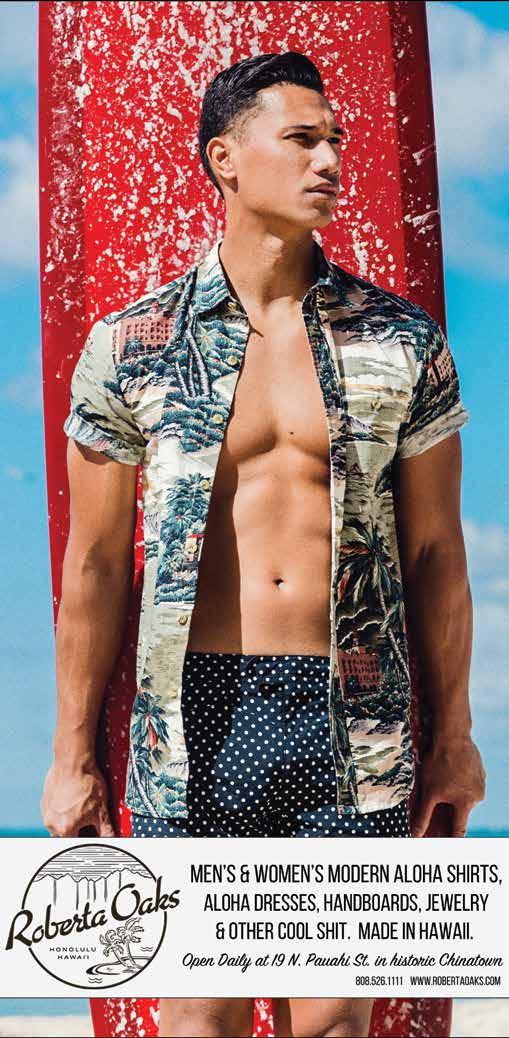
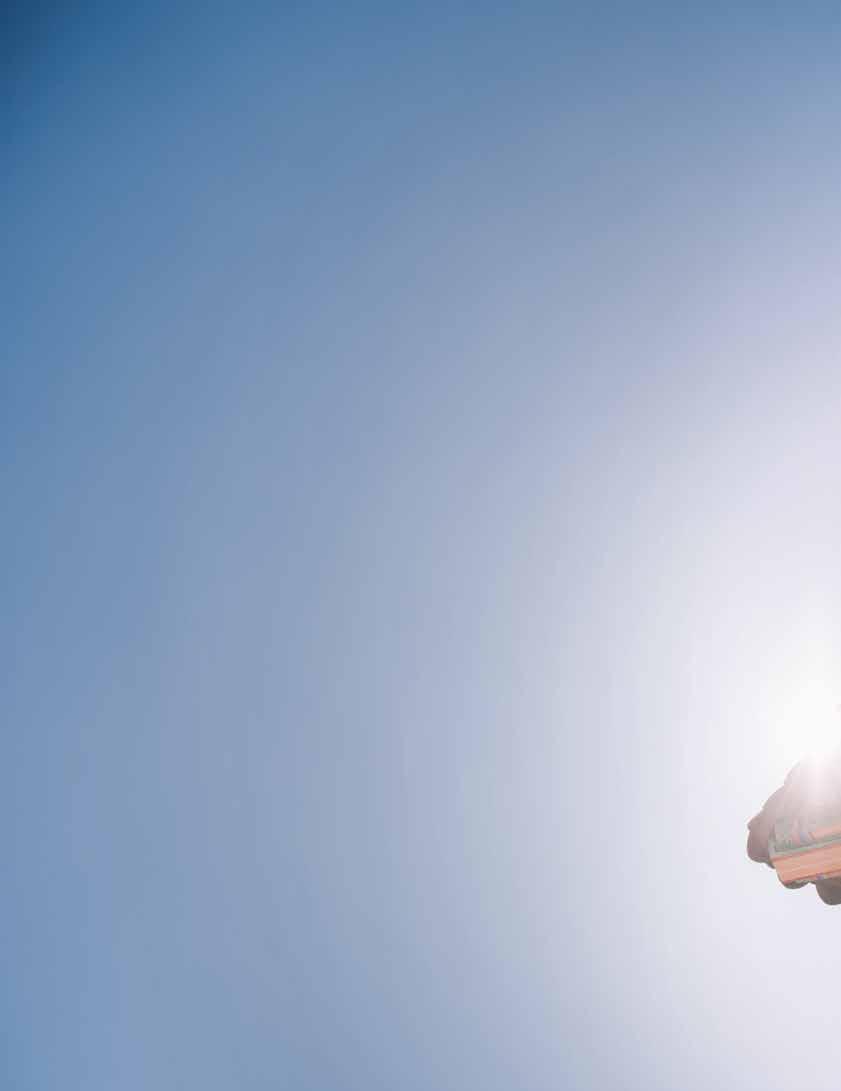
Prayer Warriors
For the Korean immigrants that began arriving to Hawai‘i in 1903, the church came to signify stability, camaraderie, and progress. Today, as the relevance of an age-old institution continues to wane, Korean devotees meditate on meeting the needs of an ever-changing community.
TEXT BY LISA YAMADA
IMAGES BY JOHN HOOK & JONAS MAON
FLUX FEATURE

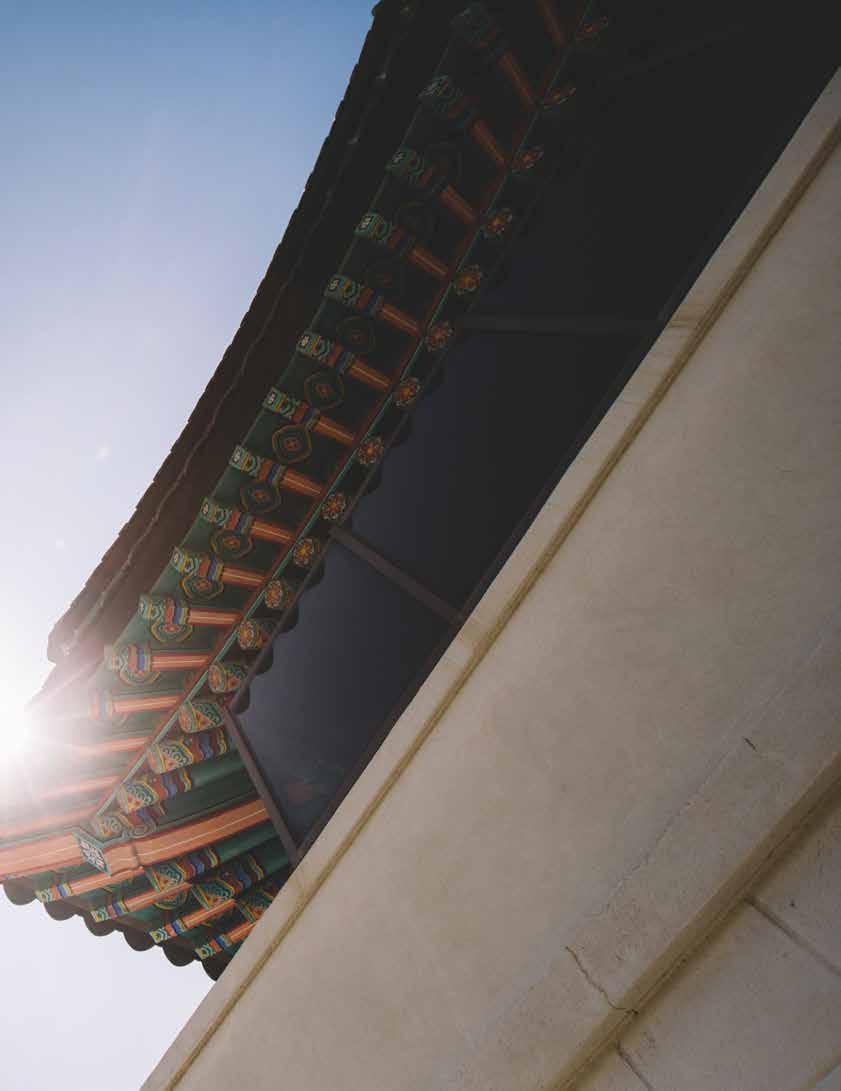
Koreans, we go out punching, then think later says omiko k ee a Korean who moved to the United tates in . don t know if by kimchi or what, but … we get so hot, sometimes it’s unreasonable. But we don’t even think about it. It’s kind of a character of oreans.
This spiciness makes sense in the context of Korea’s history. Known as Choson, or Land of Morning Calm, the mountainous peninsula of Korea has been anything but tranquil. Historically it is a sandwich nation according to Bong Rin Ro, Ph.D., a professor of church history at the Asia Graduate School of Theology on Makaloa Street in the area known as oreamok . t s a term he ses to refer to a place squeezed by world powers fighting over control of the strategic region. Over millennia, rule of Korea has shifted from China to Japan in a perpetual game of tug-of-war. Other nations, such as the Soviet Union and the United States, have joined in the contest at various times. The rope frayed so much that the country has split in two.
Amidst all of this turmoil, in the late 1880s, Protestant Christianity—as well as capitalism and Western culture—came to the peninsula in the arms of American missionaries. Within a couple of decades, Koreans began immigrating to Hawai‘i. Churches became shared places of worship, marks of kinship, and outposts for Korean liberation in the years to come. Today, only about 3.5 percent of Hawai‘i’s population, or just over 48,700 people, identifies as full or part Korean, according to U.S. Census data in 2010. Despite this, Korean culture permeates island life.
In 1903, Kea Shin Whang set off from Korea aboard the Gaelic , which was bound for the territory of Hawai‘i. Nearly half of his 102 shipmates were from the congregation of American Methodist minister Reverend George Heber Jones, who had persuaded members, many of them impoverished, to give up cruel life in Korea for the golden fields of opportunity that could be found on Hawai‘i’s plantations.
t that time the social conditions in orea were bad says ea hin s grandson Dr. Edmund Soo Myung Whang, a retired nephrologist who grew p in ahiaw . o
my grandfather immigrated with his whole family, just left with his four children and came to Hawai‘i to work on the sugarcane plantation in ah k .
For Kea Shin and the roughly 7,500 Korean migrants who arrived in the islands over the next two years, before Japan, then a protectorate over Korea, banned such migration, churches became community gathering places and networks of shared culture. Small home churches were started on plantations, while larger churches began cropping up in the cities. Sunday ser ices were an almost ni ersal feat re of plantation life for the oreans rth r . Gardner writes in The Koreans in Hawaii and the drift of non-Christian immigrants to these well-organized activities was so constant that through the years virtually all Koreans came to be identified with the hristian faith.
Soon, the church became a place to combat not only spiritual but also literal warfare in the fight for Korean independence from Japan. In 1918, Kea Shin, along with a group of 30 Koreans, formed the Korean hristian h rch in ahiaw nder the leadership of Syngman Rhee, a Princetoneducated nationalist who later became the first president of South Korea. Rhee, who had been imprisoned in Korea from 1897 to 1904 for his role in forming the Korean Independence Club, an organization that protested government corruption in its flattery of foreign powers (particularly Japan), had immigrated to the United States, where he became the spokesperson for Korean independence for the next four decades. he orean hristian h rch was established to pray for orea s independence dm nd says. hey also raised money from here [in Hawai‘i] to support the independence movement back in Korea. … The women would make kimchi and whatnot, have various sales and bazaars to generate money, and participate in war bond selling.
In 1945, it seemed that the prayers of the church were answered. Japan surrendered, World War II ended, and Korea was liberated for the first time in centuries (though the country was split along the 38th parallel of latitude—an arbitrary division made by U.S. officials to delineate the American occupation zone). The day of liberation was marked on August 15, celebrated simultaneously in the newly divided Korea as Gwangbokjeol or the
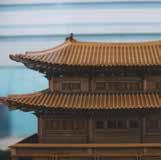
In Hawai‘i, by the mid-1970s, Koreans had the highest median family income compared to all other ethnic groups, as well as the lowest unemployment rate.
Shown right is Bong Rin Ro, a church history professor who came to the United States in 1956 as a student.
54 | FLUXHAWAII.COM
“

day that light ret rned in the o th where the nited tates had installed Rhee as president, and as k ae a al , or iberation of the atherland ay in the orth where the Soviets appointed Kim Il-sung the first premier.
Peace, however, was short-lived. The region erupted into turmoil again in 1950, when troops from the Soviet-backed North invaded the U.S.-backed South, a conflict that marked the start of the Korean War. At its end, in 1953, 2.2 million military and civilian lives were lost. For the next decade, Korea remained one of the poorest co ntries in the world. he orean ch rch is a s ffering ch rch says ch rch history professor Bong Rin Ro, who became a Christian during the Korean War, when he was 15, and now resides in Hawai‘i. t was a ery diffic lt time. lost my father and we lost o r house, and millions of Koreans died, [were] killed, or starved to death o says. till he acknowledges od sed those e periences for me to know hrist.
After the war, about 15,000 Koreans came to the United States, many as orphans adopted by families in America, war brides married to American GIs, or students seeking prestigious American educations. (Ro falls into the third category, having come to the United States in 1956 to attend Wheaton College, where he met his wife, a fifth-generation Chinese girl from aim k and where he recei ed his bachelor s in ch rch history.) The greatest majority of Korean migrants, however, came after the Immigration Act of 1965 completely did away with an earlier ban on Asian immigrants to the United States, instead giving preference to those seeking family unification or political asylum. Koreans became the third largest group of immigrants to the United States, after Mexicans and Filipinos, with 660,000 Koreans becoming naturalized citizens between 1965 and 1990. In Hawai‘i, churches swelled with Korean immigrant populations, which grew from under 10,000 in 1970 to about 25,000 in 1990. By 1980, 14 new Korean Protestant churches opened; prior to 1965, there had been just three. At Ro’s count, just two decades later, in 2000, there were 70 Korean churches across Hawai‘i; today, he puts that number closer to 90.
This phenomenon in Hawai‘i mirrored that taking place in the motherland, where church growth was also accelerating rapidly. After Korea was liberated from Japan, the number of Christians in Korea nearly doubled every 10 years, going from 350,000 Christians in 1945 to 3.5 million in 1975. (Today, there are about 7 million.) In Korea, the Yoido Full Gospel Church, which began in 1958 as a series of backyard meetings led by Pastor David Yonggi Cho, swelled to become the world’s largest church, with half a million members by the 1980s. Now, the church counts more than a million in its congregation, despite Cho having been convicted for embezzling $12 million in church funds in 2014. The more you give to God, came the impassioned cry from behind the pulpits, the more you will be blessed. h rches ha e not only p t p large impressi e
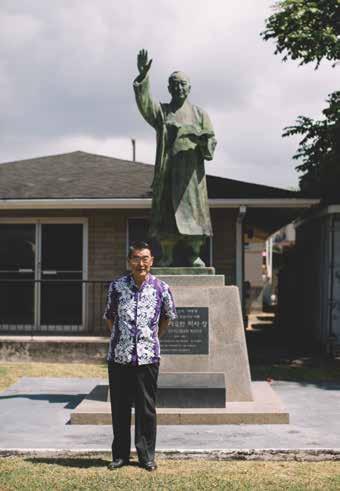
sanctuaries, they have purchased whole mountains on which to build discipleship training centers and facilities where people come day and night to pray o wrote in in an article for Christianity Today. The gospel of prosperity roared through church congregations, people emptied their pockets, and church coffers grew and grew.
In Hawai‘i, by the mid-1970s, blessings flowed abundantly. Koreans had the highest median family income compared to all other ethnic groups, including Caucasians, as well as the lowest unemployment rate. They had the highest representation per capita in the workforce, with nearly twothirds of men and half of women older than 17 employed. In terms of occupations, Koreans were more likely to work in professional services than all other ethnic groups, with the majority working in management.

56 | FLUXHAWAII.COM
Shown above is Dr. Edmund Soo Myung Whang, whose grandfather was among the first Koreans to come to Hawai‘i in 1903. Whang is pictured in front a statue of Syngman Rhee at the Korean Christian Church.

Like their peers advancing in white-collar jobs, tenacious women came to find success as business owners themselves. Among these was Tomiko Ok Lee, who migrated to Colorado in 1966 after marrying a sergeant she had met while working on a military base in Seoul. She became a burlesque dancer in Colorado, and when her husband wanted to move to Idaho to become a potato farmer, Tomiko decided she wanted her name in big lights instead. The couple split and she headed to Los Angeles, where she found success as a burlesque dancer at one of Hollywood’s most famous clubs, The Pink Pussycat. There, she was recruited to dance at Club Hubba Hubba in Honolulu’s Chinatown, where she performed until the owner began prodding her to go f lly n de. yself alone is good article omiko recalls thinking. won t do it. t the same time orean owned hostess bars began popping up around town, and the owner of Korea House, a bar on Kap‘iolani Boulevard, approached Tomiko to work in hers. he told me gi e you high-pay job, I treat you like a princess she says. hat time for most orean girls who kind of attractive, the fastest money they make is the bar.
Back then, these bars were not unlike the kisaeng houses of centuries ago in Joseon-ruled Korea, where
kisaeng, like Japanese geisha, employed charm, beauty, and a variety of talents (including singing and dancing, writing and reciting poetry, equestrianism, and even geommu , or traditional sword dancing) to entertain wealthy patrons, many of whom were influential government officials. t was a big no elty in the s and s says Dennis Lee, Tomiko’s firstborn son. en e en if they’re married or not, would come to the bar, have a few drinks, sit next to a woman, talk story, and that was the big thing.
Eventually, Tomiko worked her way to the top and came to own a total of five bars. In the industry’s heyday, she employed about 100 girls. Men from around the city piled into her namesake bar, Tomiko’s, which was located on the busy corner of Kalakaua Avenue and Kapi‘olani Boulevard, where Club Rock-Za exists today. Soon it became one of the city’s most bustling, where union bosses and blue-collar workers alike made small talk with Tomiko’s hostesses, buying rounds of drinks for both themselves and their pretty servers (although the girls’ drinks were watered down to keep them from getting too into icated . he was even a good friend of om elleck s according to Dennis, who recalls the wealth that came from his mother s bar work y

58 | FLUXHAWAII.COM


mom would be up at like 3 in the morning after the bar, and I’d hear her for hours on the calculator going, tchk tchk tchk , because she’d be counting all these checks and cash. I would see piles and piles of all this stuff. … Sometimes these checks would be like two, three thousand. … This was making a lot of money, so that brought a lot of the women o er from orea.
As the money rolled in, however, so did society’s dregs. Drugs, gambling, prostit tion orean bars became a ha en for all these illicit things ennis says. he bars became as omiko p ts it a playgro nd for the syndicate and when one of her girls got caught up in a murder-suicide, Tomiko left it all behind. he bar scene was a ery booming business … but it had ramifications, too ennis says. lot of fort nes were spent, and it disrupted a lot of families. … hat s one of the reasons got into tro ble.
Like many kids who were born in Korea but moved to America at a young age, as well as children of post-1965 immigrants, Dennis felt halfway between Korean and American, isolated from his peers and unable to relate to his mother. here was the generation that was kind of lost from the s to s acknowledges Dennis, who despite these challenges, found success in the film industry. His breakout film, Dragon Wars , which he co-produced, grossed more than $50 million. But wealth, Dennis found, was not so easy to manage, and his success sent him spiraling o t of control in os ngeles. ended p hanging around a lot of people who were in the Crips, the Bloods, some neo-Nazis, former prisoners who got involved with me because they thought I was this big Hollywood prod cer g y who co ld get them dr gs ennis says. e ran aro nd like that for a while, until money ran out, and then of course they turned on me and wanted to kidnap me, and hold me for ransom—all that kind of cra y st ff was happening.
Dennis wound up homeless, and as can tend to be the case when people encounter hardship, Dennis found himself on his knees, hands entreating heaven. At the same time, back in Hawai‘i, Tomiko was also on her knees praying for her son. prayed really hard for him e ery morning says Tomiko, who though she wasn’t a Christian,
remembered going to church when she was yo ng in orea. lease od se him for some good ca se omiko pleaded. ennis describes what came ne t as a s pernat ral enco nter with od. ince then he and his mother have been active churchgoers.
In the early 1990s, as Choson became one of the world’s 20 largest economies—a status it still very much enjoys today—Korean migration began to slow. In Hawai‘i, those formidable steeples under which spiritual immigrants used to worship en masse grew increasingly silent. hen a person gets rich and has all the material things needed, then he doesn t need od o says. his is especially tr e of the yo ng people in o th orea. Dennis agrees, pointing to his own experience, as well as to the antics of the pudgy Korean rapper Psy, whose ostentatious hit song, Gangnam Style, was actually a critique of the excess happening in Korea, where youth are notorious for their worship of Korean rock and movie stars and highly value good looks (Korea had the highest rate of plastic surgery per capita in the world in . he sad fact is that orean ch rches are dying ennis says. o see a lot of these churches all around in Hawai‘i, but the congregations are only like people.
Dennis is hoping the production company he started with his mother, Cornerstone Multimedia, which produces secular as well as hristian based flms will be a catalyst to change that. here are spirit al cas alties of money and a ence so what we re doing now is using our elements of movies and media to help people to understand that it’s not just abo t money and material wealth he says. t s really abo t lo e compassion mercy. Though the many Korean watering holes and holy places in Hawai‘i today sit nearly empty, with only those of a bygone era trickling through their doors, Ro also remains faithf l m still hopef l that od is reigning and is working in the midst of the diffic lty. s ro erbs warns hoe er tr sts in his riches will fall. hen that happens the bars and churches will be there to pick up the pieces, ready to serve all those who are thirsty.
Many kids who were born in Korea but moved to America at a young age felt halfway between Korean and American, isolated from peers and unable to relate to their parents.
Tomiko Ok Lee became a Christian after her son Dennis hit rock bottom and had a supernatural encounter while homeless in Los Angeles.
60 | FLUXHAWAII.COM
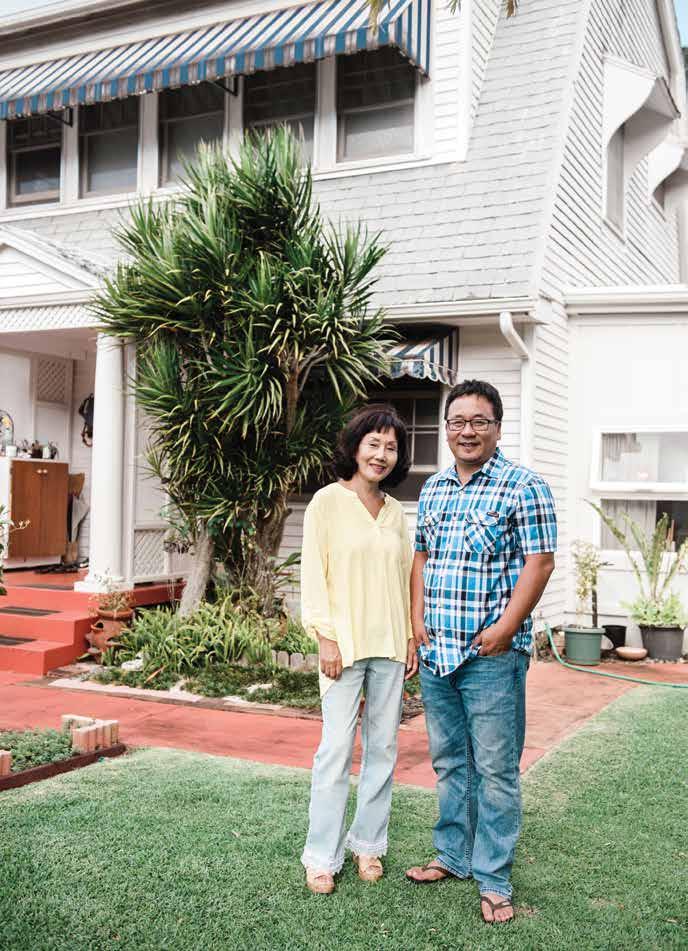
Faces of Hawai‘i’s Islam
One religion and the myriad of cultures that practice it.
TEXT BY BRAD DELL
IMAGES BY JOHN HOOK
There is a ho se in noa alley that doubles as the only mosque in all of Hawai‘i. A few thousand Muslims are members, part of the .05 percent of Hawai‘i’s population that declare slam as their religion. he noa Mosque is a hub for both Muslims and immigrants alike. Malaysians, Palestinians, Egyptians, Moroccans, Indians, local residents of Hawai‘i, people from all over the globe, gather together to worship under
the same roof, this despite having adapted slam to their li es diferently in accordance to their individual cultures. They are a people who have been hurt by the portrayal of the media—often a uniform sensationalizing—and by those who seek to harm them because of their religion and race, yet they all agree that Hawai‘i has been a welcoming harbor. The portraits featured here introduce but a few Islamic faces who have made Hawai‘i their home.
Nighat Quadri, standing in center and also featured on the cover of this issue, is shown with her husband and four children near their home in M ā noa.

62 | FLUXHAWAII.COM
FLUX FEATURE

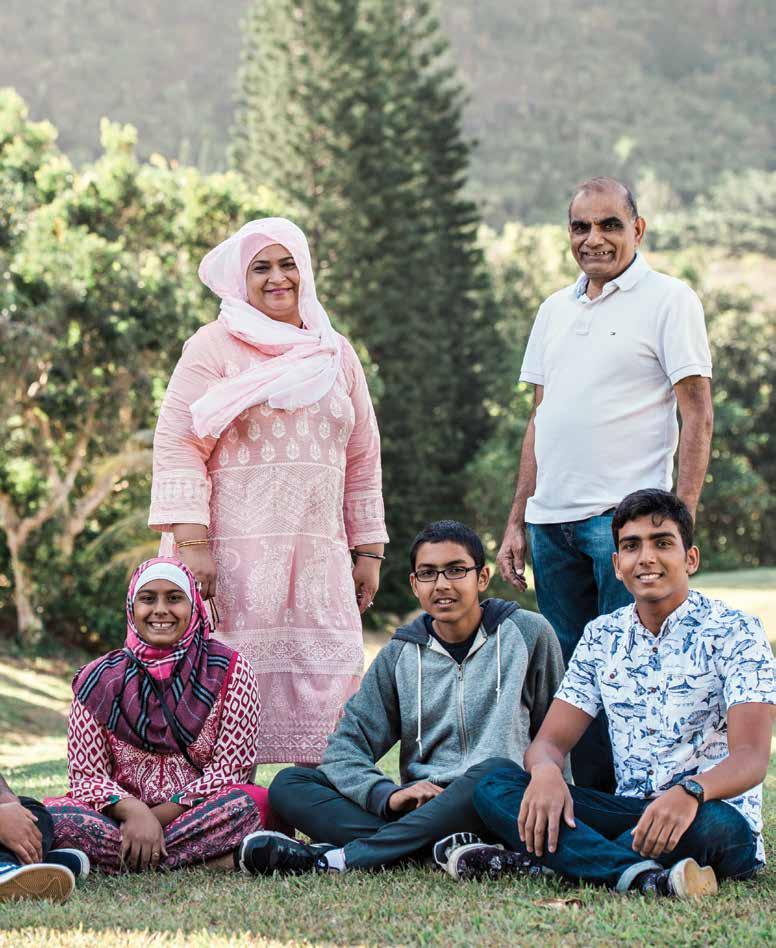
Nighat Quadri, shown on previous page occupation : Department of Health, health educator emigrated from : Karachi, Pakistan languages : Urdu, Bengali, English
On Pakistan:
I went to college over there and worked at a hospital. I never felt scared going out or anything. I always felt secure. But the law and order is more problematic now than it was at that time. I tend to wear gold all the time. I wear it over here also. And the same was in Pakistan. I would go to work, go shop, do whatever I wanted. Never felt like somebody would mug me or anything. But now, when I go there, this is the first thing that I take off. You are not supposed to go outside with any kind of special gold or anything flashy, like designer purses. Then people tend to get attracted, and you get mugged. Those are the kinds of things that have changed [from] when I was there as a Pakistani back in the 1990s.
On Emigrating:
We moved from Pakistan to Connecticut in 1997. We came because we got an immigration visa. [America has] a lottery program for some of the countries, and Pakistan was one of the countries. My husband won their lottery for immigration to America, so we came. It’s a better life, I guess. I wanted my kids to have more opportunities. It was not like I didn’t have a good job. Me and my husband had good jobs. We had a comfortable life over there. In the beginning, of course, I was very homesick. But in my mind, I left my
country, I left my parents, my mom, and my family over there. So I’m going to try to make it work. That’s why me and my husband went back to college to get a master’s degree in public health. It was hard with three kids. But I made my mind that I’m going to make it work. It did work out in the end.
On Hawai‘i:
I practice my religion freely. I go to my mosque. I wear whatever I want to wear. In many countries, we don’t have that kind of freedom. In general, America is very tolerant, but after 9/11—I was in Connecticut when that happened—there was a lot of being uncomfortable. When we moved to Hawai‘i, my goodness, it was like going back to home. Hawai‘i is very much like Karachi, which is a seaport. But also, the people over here are so welcoming in general. People are so much more welcoming. I felt the spirit of aloha right away.
Azad Abdeljawad
occupation : Entrepreneur, grocery store owner
emigrated from : Deir Dibwan, Palestine languages : Arabic, English
On Palestine:
The [Israeli] occupation is still present in the West Bank, unfortunately. Recently, a lot of killings have been happening, a lot of kids have been dying, getting killed, and the situation’s getting worse. In this day and age, the people in power can’t come to any agreements. My mom’s side is pretty war-torn. It hasn’t
been warfare, it’s just psychologically and economically. It hasn’t been a lot of guns and bullets, but it’s different ways, and maybe worse. Maybe if you kill a person, it’s better—they don’t have to live through it. When you cut the food away from them, you raise the prices, you limit their freedom, you live like a chicken in a cage. You can’t go anywhere. There’s some places where there are land mines all over the place. There are signs [that say] if you step over here, you might blow up.
On Emigrating:
I came [to Hawai‘i] in 1997, when I was 5, [with my parents and sisters]. The occupation was getting worse. It’s to the point where if you can come to America, you might as well just come. Now [at 22] I own this grocery store [in Kalihi]. It’s like the American dream, you know? I’m just fortunate because Hawai‘i’s a really tough place to make it out. I’m just happy, I thank God for everything. [People from Palestine] are happy for me, but I can see the jealousy in their eyes.
On Hawai‘i:
Fortunately, Hawai‘i is very kind to other ethnicities, other religions, and whatnot. So I’m very happy that we don’t have to face discrimination that the Muslim communities face in other states. The Muslim community here is supportive anytime anything happens in Gaza or anywhere in Palestine. I wish we could have more mosques, that we could have more locations so we can reach out more. But the Muslim community here is really limited, so right now, the mosque we have does a good job in accommodating.
64 | FLUXHAWAII.COM


Douniya Ahmed
occupation : Chinese and Korean lang age st dent at H noa emigrated from : Ali Sabieh, Djibouti languages : Somali, English, Chinese, and some Korean
On Djibouti:
We lived in huts, basically. It’s very rural. You’ve heard of Somalia, right? We were split from them, but we’re the same people. We speak the same language. Djibouti is a very, very poor country. We didn’t have skyscrapers. You had to be super rich to have cars. It was only the French military there that had cars. People like us just walk or take a train. It’s the second smallest in all of Africa, so it’s very community oriented. That’s why I kind of like Hawai‘i, because everyone is nice and all of the locals are pretty chill.
On Emigrating:
My dad worked for the Red Cross, and they gave him the opportunity to move to the United States. When my parents told my grandparents and uncles that we were going, they didn’t believe us. They kept saying e don t belie e yo we don t belie e yo . nd then we left. t was pretty epic. We felt like we were in a movie. It was like the American dream. For the first year and a half, we were sent to Texas, and that was in 2001, right after 9/11. So it didn’t work out. The people were crazy. People put graffiti on my house and said terrible things. The kids and my mom moved up to Seattle, and my dad followed us afterwards. When we lived in Seattle, we actually lived in a shelter for the first year up there. Then we got on our feet. Now we have our own house in Hawai‘i. I didn’t really understand when I was younger. Now I’m older, and it’s like, wow, we were actually at the bottom.
On Hawai‘i:
Most [prejudice] is from tourists. I work at Walmart and I have some tourists, from the South or whatever, and they’ll come and demand another cashier. Or they’ll stand in line, and when they see I’m their cashier, they’ll leave. Last month got of of work and was taking the b s home, and the bus driver refused to let me on his bus. That was late at night, and I had to walk home. I don’t hear about much racism towards other girls at the mosque, though. Being a black Muslim, I’m the bottom of the barrel.
66 | FLUXHAWAII.COM

Maseeh Ganjali
occupation : Stage actor, director
emigrated from : Tehran, Iran
languages : Persian, English, some Arabic
On Iran:
[Iran has] a very two-dimensional portrayal in media. It’s not the Iran I know. It’s not to say that Iran’s not limited in some ways, but the complexity of it all is always missed in the media here. It’s still a young government. It’s sort of a new country with a lot of young people. Majority of the population is under 30 years old. So that means they’re figuring a lot of things out, and in that process, not everything is going to be fantastic. I miss Iran’s poetry and the performing arts. Poetry was always a part of my life, a part of our culture.
On Emigrating:
Before coming to Hawai‘i, I told myself on t ha e any e pectations and take it all in as it is instead of expecting it to be a certain way or always comparing it to what you’re used to. I think coming to Hawai‘i with that mentality really helped me to adjust and to sort of accept everything. It helped me in understanding the people and the culture here. I remember I got to Hawai‘i on the 3rd of August 1997, [when I was 13], and [Kaiser High] School started the last week of August, and I didn’t speak any English. My dad dropped me off at school and was like, ‘I’ll see you at home.’ And I realized, okay, if this is going to happen, I’m going to have to do it on my own. So it took me about four months to understand what’s happening around me, and over a year to understand the conversations people were having. After about two years, I was able to engage
in those conversations in a way that I’m comfortable.
On Hawai‘i:
Part of being in Hawai‘i is accepting diversity. As long as you’re okay with people and don’t cause trouble, people are friendly. I guess it’s part of that aloha spirit. But it’s a very interesting place, Hawai‘i, because we’d like to think racism doesn’t exist and prejudices are not really on people’s minds, but they are. Whether it’s towards Muslims or any other group of people. You think of other minorities that come here. They experience a lot of prejudices. So to say Hawai i is all aloha and no pre dice is not really facing reality. And I have experienced prejudice, but the times I have received love from people outnumber those bad experiences by millions to one.
FLUXHAWAII.COM | 67



IN FLUX
FLUXHAWAII.COM | 69
70 | Olay’s Thai Express
74 | Hide Sakurai
78 | Micronesia
Crossing the River
One mother risks it all for the sake of her family.
TEXT BY KELLI GRATZ
IMAGES BY JOHN HOOK
At Olay’s Thai Express in iea andy lay Somsanith sits comfortably in a chair, her hands tender from working in the kitchen all day. Dedicated patrons flow in and out of the humble space, which smells richly of lemongrass and basil, and are greeted by Somsanith’s daughter Macy Khouneko, the second of six children. At 59, Somsanith

has been in the food industry her entire life, though this is loose terminology, considering she started as a young girl selling vegetables on the streets of Don Kho in pre-socialist Laos. efore it was easy whenever you want to do, go sell go school do whate er Somsanith says with a heavy aotian accent. fter the communists come, we have to follow what they tell us to do. s a yo ng ad lt Somsanith witnessed the harsh nature of the Pathet Lao, as they worked to build a new socialist society. They struck first at food speculators, closing down markets and occupying the stores of major import merchants, forcing many citizens to leave for Thailand. Somsanith and many other peasants were constantly checked and asked by soldiers for travel documents when they attempted to bring food and animals to town to sell. The flow of food to the urban areas began to dwindle, and in response, government ministries were urged to grow their own vegetables and raise poultry and livestock. When Somsanith was finally recruited to work on one of these farms, she feared her daughter would be taken
Thirty-six years ago, Sandy “Olay” Somsanith fled a newly socialist Laos, swimming across the Mekong River with her daughter on her back, in search of a better life for her family.
70 | FLUXHAWAII.COM IN FLUX | FOOD |
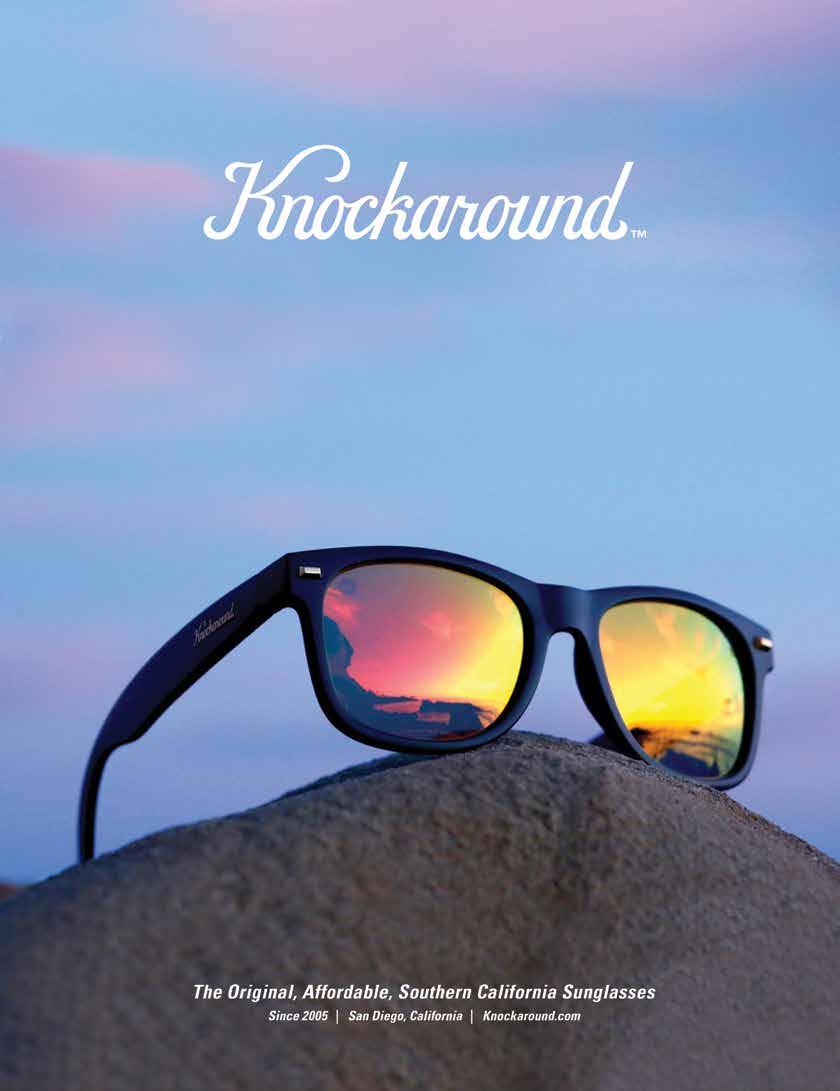

from her. There was only one choice to be made: Somsanith knew they had to flee.
So, on a fateful day 36 years ago, Somsanith packed all of her belongings into a large plastic bag and filled it with air to prevent it from getting wet, then set out for the Mekong River. With her 2-year-old daughter, Nokdavanh, on her back, Somsanith made the three-hour swim across the river, through heavy rainfall and flooding, each stroke accompanied by the looming threat of alligators. t was not too far b t take long she recalls. swim st little bit little bit. Arriving as refugees on the eastern coast of Thailand in the Ubon Ratchathani province, Somsanith and Nokdavanh ran for cover in a camp nearby. t was ery scary she says. f the army see me they kill me.
The family had escaped the Pathet Lao regime, but tragedy soon struck. Not long after Somsanith’s husband was reunited with them—having come from another refugee camp located nearby—Nokdavanh died s ddenly of an nknown illness. he r n she happy b t at night her stomach Somsanith says. take her to hospital three days later she passed away.
Desperate for a better life, Somsanith wrote to Vieng Bounthong, an old friend who had lived near her in Don Kho, who had since moved to California. He agreed to sponsor Somsanith, pledging to help ease the family’s
transition into America by setting them up in a place to live and covering their living expenses while they looked for work. So in 1980, after a year and a half of living in the camp, Somsanith’s family boarded a plane to Orange County. Somsanith had given birth to the couple’s second child, Chanhthay Dou, only weeks before. hen come to merica my baby only 2 week old, and had no diaper, nothing she says. don t know how to ask for anything. no speak nglish
Somsanith worked odd jobs in California, then Utah, until in 1993, she and her family moved to Hawai‘i, where a cousin was living. Five years ago, marking the apex of a long uphill journey, Somsanith opened her own namesake restaurant, Olay’s Thai Express, in ‘Aiea.
y mother s life is pretty ama ing says Khouneko, taking a break from running the front of the restaurant. Her black hair and brown eyes resemble her mother’s, but when she speaks of Somsanith, her face brightens like that of a child. owe her so m ch. his is why I do what I do, even though it can never be enough to repay her for what she did for me and my siblings. They had recruited her to go work on a farm, pretty much like slavery, but she didn’t want to be owned by anyone. … he risked it all for a better life for all of s.
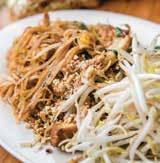
Olay Somsanith is shown with her daughter Macy at her namesake restaurant, Olay’s Thai Express, which they started five years ago in ‘Aiea.
Find Olay’s Thai Express at farmers markets around O‘ahu, as well as at its ‘Aiea location, 99-927 Iwaena St.
72 | FLUXHAWAII.COM

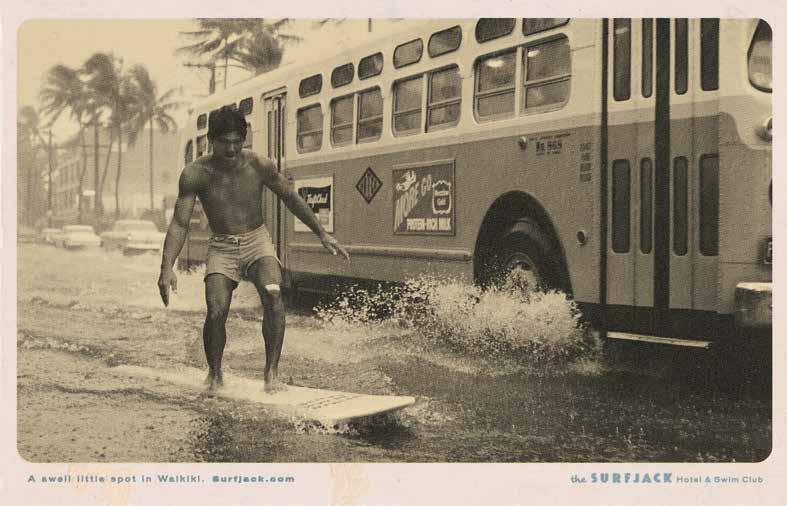
Four-Sight
Tokyo-born restaurateur Hide Sakurai fnds his niche.
TEXT BY MARTHA CHENG
IMAGES BY JONAS MAON
Hide Sakurai is too big for his niches. This is why the 39-year-old Honolulu restaurateur, who debuted Shokudo in 2005, Búho Cocina y Cantina in 2014, and Bread and Butter within a year of that, is already moving forward with his fourth concept and sketching o t a ffth in his head.
Born in Tokyo, Sakurai worked in restaurants throughout high school and college. His big break was not earning the law degree he was studying for, but rather was working his way up the ranks of TGI Fridays, where he began bartending in Shibuya, then graduated to managing the chain’s Shibuya and Ginza locations, and then rose to general manager of TGI Fridays Japan. In fact, Sakurai so impressed the CEO of TGI Fridays Japan, Tetsuya Emura, that the two partnered to start their own empire. They zeroed in on Hawai‘i, with its developed Japanese community and what Sakurai calls a rice c lt re a
large consumption of and love for rice. This is where they wo ld start their frst venture.
Their restaurant, Shokudo, dazzled diners when it opened. At night, the 200-seat, glass-walled space lights up in bright white and red, arresting attention on the corner of busy Kapi‘olani Boulevard and Kaheka Street near Ala Moana Center. Soaring ceilings, an enormous hooped chandelier, and tiered dining tables make each meal a spectacle—one that often ends with the restaurant’s towering honey toast.
A conversation with Sakurai is a lesson in market research. In Hawai‘i, which has been home to families of Japanese ancestry for more than a century, and continues to draw more than a million Japanese nationals annually, he noticed that diners loved Japanese cuisine. But despite these afections he fo nd that no casual, well-designed Japanese restaurant existed. On one end of the culinary
Japan-born Hide Sakurai has found success in Hawai‘i with three popular restaurants, including café and wine bar Bread and Butter.

74 | FLUXHAWAII.COM IN FLUX | FOOD |



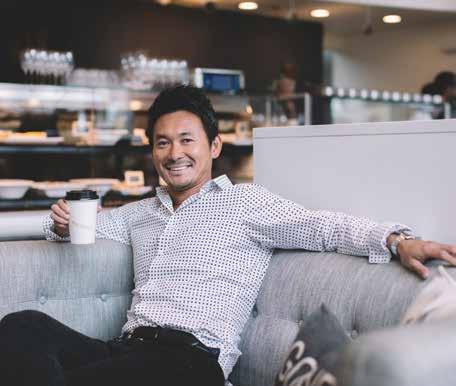
spectrum, there were izakayas, Japanese bars that average $50 per person for a few hours of drinks and small dishes, and on the other end, were budget-conscious mom-and-pop Japanese joints. Shokudo was his answer to the need he saw for an afordable apanese resta rant that also ofers the ambiance of a nice night on the town.
Sakurai loves well-designed, big spaces, counting on them to translate into big n mbers. his paid of with hok do. His friends worried for him tho gh when he frst opened the 12,000-square-foot Búho Cocina y antina in b stling aik k on the ffth oor of the aik k hopping la a a location which translates to ero street frontage. t see the f t re ak rai says. pict red it. If you think about niche marketing, who else has a good, massive rooftop in the middle of aik k where yo can get a f ll meal Búho’s initial year was slow, but by its second year, the restaurant drew $4 million in revenue, thanks to the spectacular views of the aik k skyline li e m sic at night a bar that stretches along the entire length of the restaurant, and its upscale Mexican dishes. Wait, upscale Mexican?
ook at who s s ccessf l in aik k with [our target] volume of business: Cheesecake Factory, Yard House, Duke’s, all of them in to price range ak rai says. ho s there? Most likely Americans. A lot of people


think Japanese-Japanese, but the Japanese tourist market doesn’t have more than 30 percent market share. Mainland U.S. tourists hold more than 50 percent market share on ah . ak rai co ldn t compete with the chains and local heavyweights in American food, so he built a menu based on another cuisine beloved by Americans: Mexican.
The restaurateur has a head full of numbers, such as square feet, revenue, market share. But he doesn’t let numbers dictate everything. For instance, Bread and Butter, a café and wine bar ne t door to hok do has yet to fnd its groo e. don t need to look at the fnancials for that he says. t s too slow. f yo look at n mber number, number, [you think] shrink, shrink, shrink. You can’t do that. You need to think of the c stomer frst. lose the book. hen feel what it is exactly they want. You need to feel it. t present ak rai s g t is telling him that Bread and Butter diners want $20 paella and pinot nights.
In the meantime, Sakurai is working on his fourth concept, a 10,000-square-foot space behind Búho. For this, he’s considering a latenight destination centered less on drinking and more focused on pool, darts, and karaoke. There will, of course, still be a bar, and—this being one of Sakurai’s signature spots—an interior announcing that you have arrived in a place unlike any other in Honolulu.
Shown right, upscale Mexican offerings from Búho Cocina y Cantina, Sakurai’s second restaurant in Honolulu.
For more information, visit: alohabreadbutter.com buhocantina.com shokudojapanese.com
76 | FLUXHAWAII.COM
Shown left, Sakurai takes a break at Bread and Butter.
Alex and Ani
Alex and Ani creates meaningful, ecoconscious jewelry and accessories to positively empower and connect humanity. Sharing a passion for the wellbeing of our planet, our communities, and our individual paths, Alex and Ani products are proudly designed and crafted in America and made with love. With each collection, the brand invites you to be your own designer by ofering the ability to mi symbolic pieces with your own alchemy, making Alex and Ani completely and distinctively yours. The new Alex and Ani Ala Moana location houses the brand’s most popular stackable, charmed bangles, including the exclusive Aloha bangle and the Path of Life and Charity by Design lines, the latter of which promote and support over 44 charitable organizations around the world.

Featured bangles from top: Jordan beaded expandable wire bangle, Rafaelian Silver finish, $38; Aloha expandable wire bangle, Rafaelian Gold finish, $32; Bamboo beaded expandable wire bangle, Rafaelian Gold finish, $38; Euphrates beaded expandable wire bangle, Shiny Silver finish, $38; Cosmic Balance expandable wire bangle, Rafaelian Gold finish, $28; Nile
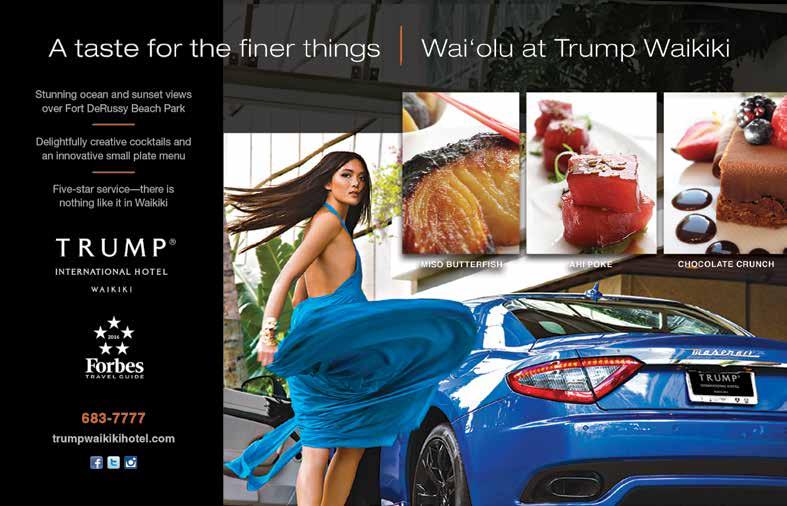
FLUXHAWAII.COM | 77 IN FLUX | PROMOTIONAL |
beaded expandable wire bangle, Shiny Silver finish, $38; Mykonos wrap, Two Tone Shiny finish, $38; Kingston wrap, Rafaelian Silver finish, $48; Gypsy 66 wrap, Shiny Gold finish, $58.
Visit Alex and Ani Ala Moana, now open at at Ala Moana Center, Ewa Wing, 3rd floor.
Atom Bombs and Rising Seas
As climate change continues to threaten Micronesian communities, Hawai‘i may be faced with its own migrant crisis.
TEXT BY TINA GRANDINETTI
IMAGES BY TINA GRANDINETTI & KARL FELLENIUS
Tell them about the water / how we have seen it rising / ooding across o r cemeteries / and crashing against our homes / tell them what it’s like / to see the entire ocean level with the land.
Excerpt from “Tell Them” by Kathy Jetnil-Kijiner
An estimated 15,000 to 18,000 people from the Oceanic region of Micronesia, which includes the Federated States of Micronesia, the Republic of Palau, and the Marshall Islands, currently reside in Hawai‘i. They are the most recent additions to Hawai‘i’s diverse population, adding such ethnicities as
Kosraen, Chuukese, Marshallese, and Palauan to an already mixed plate of cultures. Despite Hawai‘i’s aloha spirit, the Micronesian community living in the isles face daily discrimination and institutional racism—painted on the faces of ignorant passersby, eruditely written into state legislation, scrawled in mean, spray-painted letters on the walls of Micronesian-owned businesses. It is likely that over time, the Micronesian community will follow a familiar arc traced by many other migrant groups in Hawai‘i: discrimination cracking under empowerment, eventually giving way to acceptance. But as climate change intensifies and makes life in Micronesia’s low-lying atolls exceedingly difficult and uncertain, the Micronesian community, both at home and in the diaspora, are engaged in an even greater struggle to protect their homelands and culture from being engulfed in an ever-rising sea.
To understand Micronesian migration to Hawai‘i, we must begin in February 1946, when U.S. military governor Commodore Ben H. Wyatt asked the people of Bikini Atoll, a chain of islands within the Marshall Islands, to temporarily leave their island so that the United States government could test atomic bombs for the good of mankind and to end all wars. fter m ch deliberation, the Bikinians reluctantly agreed to relocate to Rongelap Atoll. Upon their departure, the United States Armed Forces unleashed nuclear hell on Bikini Atoll, 67 times. The most powerful of these bombs was 1,000 times more powerful than the bomb that destroyed Hiroshima, and it left an underwater crater a mile wide and 200 feet deep where parts of the palm-tree laden atoll, including three islands, had previously been.
Although Bikini Atoll had been cleared of human life, clouds of irradiated coral dust drifted far across the Marshall Islands, leaving islanders poisoned, their skin burned and blistered, their blood contaminated by
radiation, and their people exiled. Years later women birthed stillborn elly babies and pristine white sand left radioactive burns on bare feet. When questioned about the debacle in 1969, then-Secretary of State Henry Kissinger reportedly replied here are only 90,000 of them out there. Who gives a damn
This legacy defined the United States’ relationship with its Micronesian territories, then defined as the U.S. Pacific Trust Territories. In the 1960s, as calls for liberation roared throughout the colonized world, the United States government drafted the Solomon Report, a document which outlined a political strategy to ensure that Micronesian island nations would remain politically and economically dependent upon the United States, even after the trust was dissolved. Unwilling to give up such a strategic swatch of land, the United States poured food and monetary aid into the region, but invested little in its sustainable governance and development. Eventually, the Federated States of Micronesia, the Republic of the Marshall Islands, and the Republic of Palau became independent nations. But the United States was able to retain military control of more than 2 million square miles of the Pacific through the international agreement known as the Compact of Free Association, or COFA. In exchange for this military jurisdiction, the United States promised economic support to the three signatory nations, and gave COFA citizens an open door to enter into the United States.
Today, nearly one-third of the population of COFA nations live abroad, mostly in pursuit of healthcare, jobs, and education. This massive migration represents opportunity, but is also deeply entwined in a complex web of aid dependence that has been spun by the United States in order to maintain control over this strategic region. Sizeable communities of COFA migrants have formed on the U.S. mainland, including
78 | FLUXHAWAII.COM IN FLUX | VIEWS |

in Arkansas and Oregon. Unsurprisingly, given Hawai‘i’s geographic proximity and shared island culture, many Micronesians have chosen to make it their home away from home.
Now, experts are predicting an even larger exodus from Micronesia, as rising seas threaten to force people from their paradisiacal but vulnerable homes. For the second time in less than 100 years, powerful global actors are being questioned about their roles in Micronesia and are responding with a metaphorical ho gi es a damn This time, the issue is not a debate over the devastating effects of nuclear testing—though Micronesians still suffer elevated rates of thyroid, colon, and other cancers—but rather those of climate change.
In order to avoid catastrophic impacts, the maximum temperature rise accepted by the international community is a two-degree Celsius global average. This threshold, however, could be a near death sentence for the low-lying islands and atolls of Micronesia. Scientists predict that at the current rate of global warming, sea levels will rise between one to four feet by the end of the century, a terrifying projection for the
people of the Marshall Islands and the Federated States of Micronesia, where most atolls are only about seven feet above sea level and are rarely wider than a football field. Already, king tides and storm surges have destroyed homes, drowned crops, and rendered agricultural lands salt-ridden and unsuitable for food production. Even if Micronesian atolls resist sinking via the accumulation of coral, more frequent, violent storms induced by climate change will still render shorelines and lifestyles unstable.
The most dangerous impact of sea level rise, however, according to Lowell Alik, director of the Republic of Marshall Islands’ Office of Environmental Planning and Policy oordination is that saltwater will eventually infiltrate underground water reso rces. n the worst case scenario, it is the loss of freshwater that will render low-lying atolls uninhabitable.
Alik’s department is the Marshall Islands’ first point of contact for multilateral environmental agreements. The office is part of a growing effort by Micronesian nations to pressure the international community to act swiftly against the devastating progression
Life in Micronesia may grow exceedingly difficult as climate change threatens the subregion’s low-lying islands.

The heart of Chinatown since 2005

of climate change. Leaders like Anote Tong, president of Kiribati, and Tony de Brum, former foreign minister of the Marshall Islands, have rejected the idea that their nations should be the world’s proverbial canary in the coalmine. De Brum stirred controversy in a 2015 interview with Radio New Zealand, when he likened climate changeinduced migration to cultural genocide, saying isplacement of pop lations and destruction of language and culture is e i alent in o r minds to genocide. Reminding industrialized nations that they would be accountable for this crime de r m contin ed eople must know that climate change can be re ersed if we do it now. imilarly at a 2015 address in France, Tong told world leaders o r emissions don t remain your emissions; they become mine, and I have the right to determine my emissions which yo create.
Already accustomed to delivering emotive speeches about the rising tides affecting their islands, in the months ahead of the COP21 UN Climate Change Conference in Paris, Micronesian leaders campaigned tirelessly to lower the globally accepted temperature rise from 2 degrees to 1.5 degrees Celsius. Short of ratifying this new target,
the signatories to the final Paris deal committed to keep global temperature rise well nder degrees and to p rs e efforts to keep that fig re below 1.5 degrees. After years of seeing little progress, this was a minor victory for Micronesians, yet it was also a sign that the world may finally be ready to listen to those on the front lines of climate change.
Global efforts have not kept pace with the growing pressures placed on already vulnerable populations. In the Marshall Islands, the exiled Bikinian community has recently petitioned Congress to allow it to use a $69 million relocation fund—first granted by the U.S. government for use in relocating within the Republic of the Marshall Islands—to instead be utilized to move to the United States. Though this is a last resort, frequent flooding of Bikinian lands on Kili and Ejit islands have made preparation for this worst-case scenario a tragic necessity.
Fed up with a global discourse that seems resigned to the destruction of low-lying nations, people like Kathy Jetnil-Kijiner have also stood up to tell the world that low-lying nations will not concede to a future identity as climate change refugees. Jetnil-Kijiner,
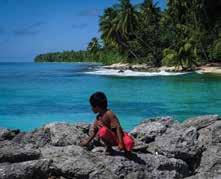
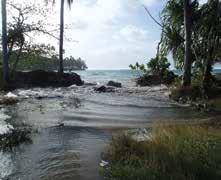
a Marshallese poet who spent much of her life in Hawai‘i, addressed the United Nations Climate Summit in 2014 with a poem that defantly anno nced to her young daughter that their home will not be swallowed by the sea, because, she wrote e are going to fght.
As the impacts of climate change also intensify in the Hawaiian Islands, our collective concerns will inevitably begin to align with those of our Micronesian neighbors. Thankfully, the Micronesian community in Hawai‘i has proven to value solidarity, even as they have faced hardship and discrimination head-on in our islands.
As rising seas threaten to force Micronesians from their paradisiacal but vulnerable homes, powerful global actors are responding with a metaphorical “Who gives a damn?”
80 | FLUXHAWAII.COM
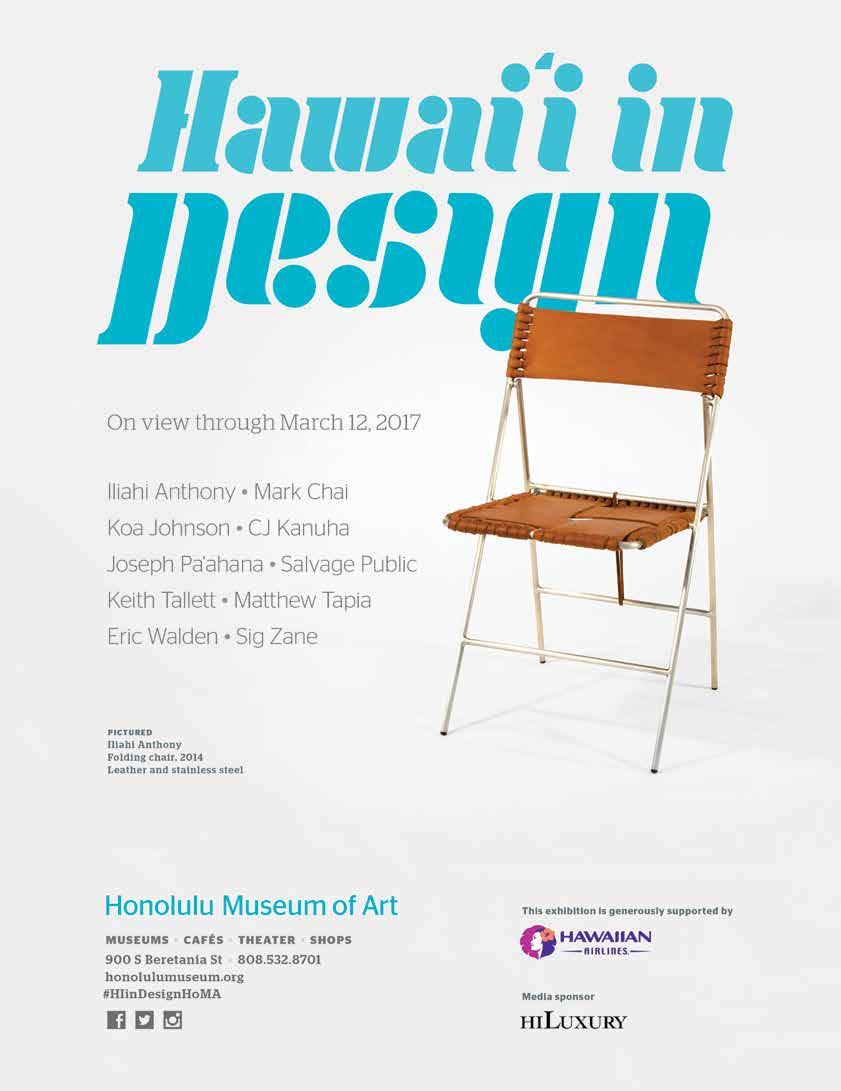
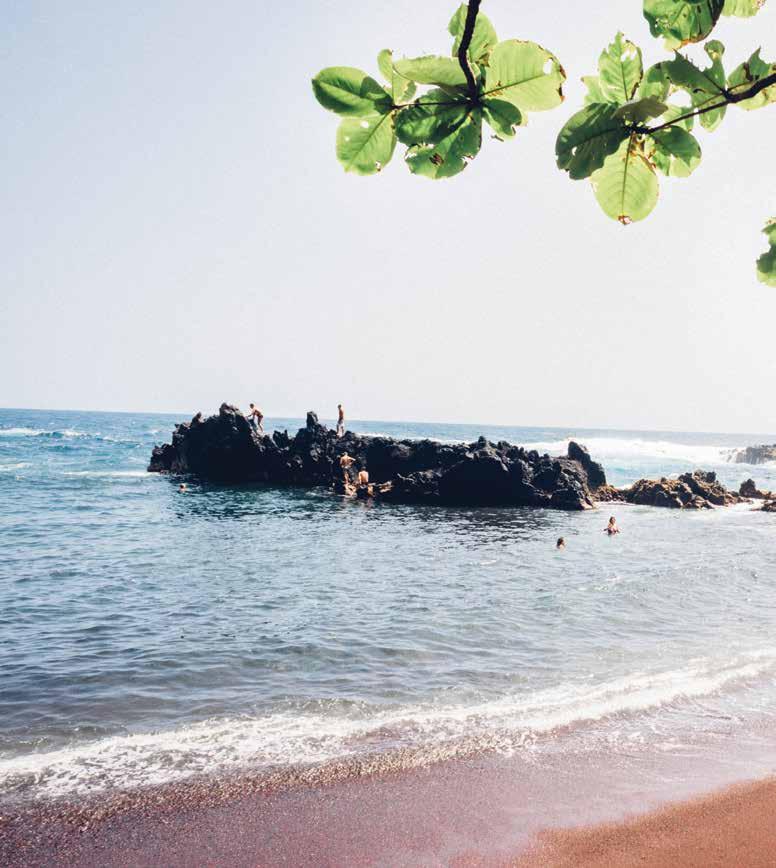
Escape!
Special Travel Section
It is only too easy to forget about the bounty of adventure that awaits in our own backyards. Discover refreshing ways to take a vacation, whether it’s exploring a remote location on a neighbor island for the first time or looking differently at a place we’ve known our whole lives.
82 | FLUXHAWAII.COM
86 | H ā na 94 | Wailea

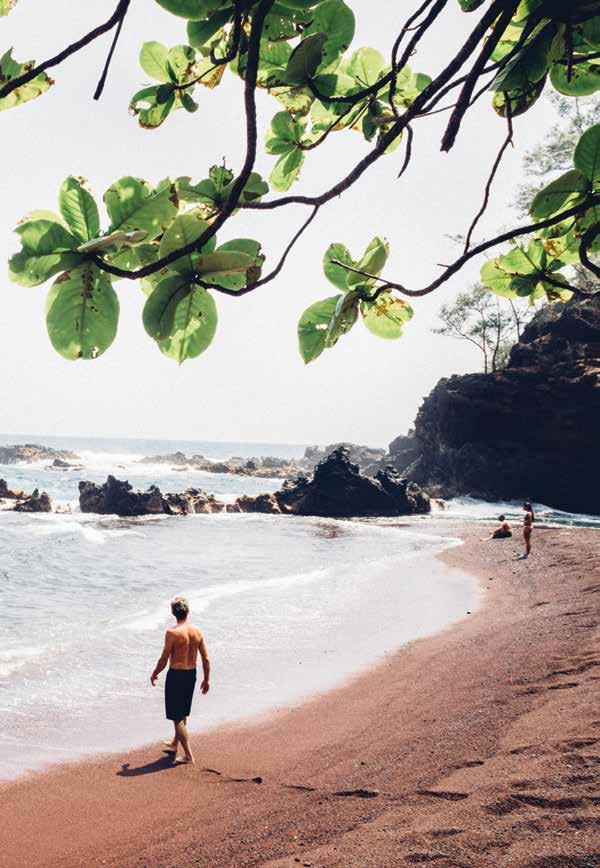
‘ Ō KOLE MALUNA, BOTTOMS UP Starwood Hotels and Resort Hawaii’s bartender specialists, wine connoisseurs, and mixologists infuse local culture and fresh ingredients into timeless inventions, incorporating them into refreshing twists on old favorites and creating neo-classics in the process. Whether you’re on Maui, Kaua‘i, or O‘ahu, you can escape to any of the Starwood Hotels and Resorts Hawaii properties to sip and savor rich island flavors prepared in an artisanal manner. Read on throughout this section to discover carefully crafted libations that draw on the rich history of the Hawaiian Islands.
Kaihalulu Bay, more commonly known as Red Sand Beach, is located along Maui’s famed Road to H ā na.
98 |
102
Waimea
| Kalihi
FLUXHAWAII.COM | 83
| PROMOTIONAL |
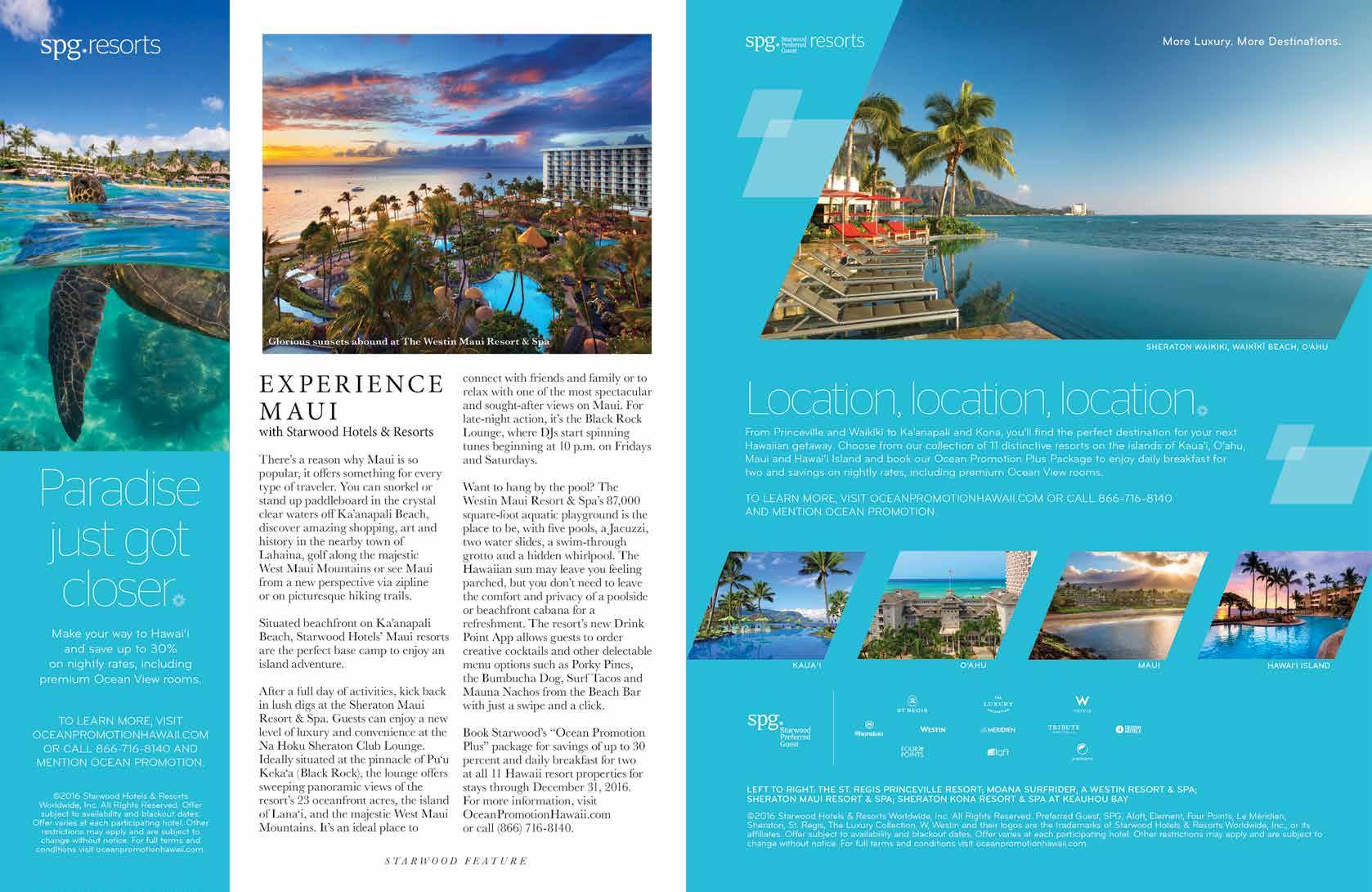

The Journey
Rather than just rushing along the dizzying ad na s a he ni h a he end the journey (heck, stay a week!), and let this ea ca e seduce u.
TEXT AND IMAGES BY IJFKE RIDGLEY
It would be a mistake to think that the journey to H na miles of hairpin turns through dense jungle and along sheer cliffs—is more important than the destination. hile H na Highway offers enough roadside attractions and worthwhile detours to turn a two-hour car ride into an eight-hour adventure, it is precisely the difficulty of this
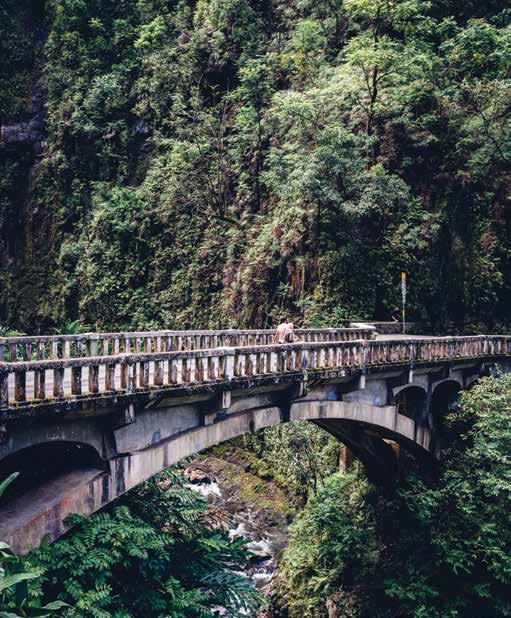
journey that makes the final destination so special. H na grew rapidly in the late 1800s when six sugar plantations were operating there, but many families moved away once the plantations closed after World War II. These days H na s appro imately 1,200 residents—both locals whose families have been there for generations and visitors so seduced by the area that they decided to stay—are committed to keeping the area largely unchanged. Unlike other sleepy country villages in Hawai‘i that see residents commuting to town every day for work locals of H na live and work there, rarely leaving more than once a week. This small footprint makes for a tight-knit community, one whose members must rely on each other and the land. hat makes H na so special is the people says po ailo a staff member of Kahanu arden. e gen inely care about the people, the family, the ocean the ina. t is the commitment that we made to o r families to o r k p na that this land is going to stay like this for generations to come.
The Road to H ā na is 52 miles of treacherous turns through dense jungle, but it is precisely this difficulty that makes the journey renowned.
86 | FLUXHAWAII.COM ESCAPE | H

Hā na’s tight-knit community of residents, both locals with generations-long ties to the area and visitors so seduced by it they decided to stay, are committed to keeping the area largely unchanged.
FLUXHAWAII.COM | 87

TO EAT:
RUST BUCKETS
f one of the c r es on the oad to H na located closer to the beginning than to the end yo will fnd the st Buckets food truck in a lush clearing. Reggae music may or may not be on blast, and Jesse Nako‘oka, owner of the Live One Day Hawaiian Adventures company that shares the same plot, may or may not be on hand to hack open a fresh coconut for you. But there is certainly lunch to be had. Today, Rust Buckets owner Kapono Tumale is ser ing p a mo ntain of k l a pork and barbeque chicken with brown rice, fresh pineapple, and grilled banana. All of the food is made fresh daily and uses locally sourced ingredients, which means that whatever Tumale and his friends hunt, fsh or gather may make an appearance including rack of goat, beef ribs, prawn curry, or fresh ahi. Rust Buckets’ livefrom-the-land ethos even extends to its dishware: To minimize waste, Rust Buckets’ food comes served on plates made of banana leaves.
THAI FOOD BY PRANEE
The days that this food truck are open are limited, and it only serves lunch,
but who ever said that getting the good st f wo ld be easy n a small road o erlooking the H na ier a red sign points you in the direction of the best Thai food around. Originally a food vendor in Bangkok, Pranee Collins came to H na in and started cooking for private parties in town. Demand for her delicious dishes quickly grew, and she opened her food truck eight years ago. These days, Collins whips up two specials daily, or will make you her other menu items to-order, but come early, as it all tends to sell out quickly. You can’t go wrong with the house specialty: deep fried opakapaka (Hawaiian pink snapper) with green mango salad. A fan favorite, this item is crispy on the outside, moist on the inside, light, tangy, and refreshing. ays one H na local ggling f e takeo t orders of it ait til yo taste the lime dressing
TO SEE:
HASEGAWA GENERAL STORE o trip to H na wo ld be complete without a visit to Hasegawa General Store, a true old-fashioned general store open since 1910, found on the way out of town heading toward Seven Sacred Pools. Part grocery store, part hardware
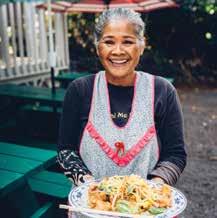
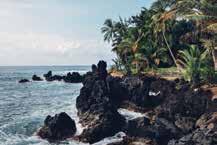
store, with a smattering of souvenirs and recreational items, Hasegawa’s has been supplying locals and visitors with all that they need for more than 100 years. ts specialty achetes. e carry the largest selection of machetes on the island says eil Hasegawa the fo rth generation owner of this family-run b siness. ys dri e all the way from ah l i for my machetes.
RUST BUCKETS: 10301 Hana Hwy.
Open Sunday–Friday, 8 a.m.–4:30 p.m.
THAI FOOD BY PRANEE: 5050 Uakea Rd.
Open Saturday–Tuesday, 10:30 a.m.–4 p.m.
HASEGAWA GENERAL STORE: 5165 Hana Hwy.,
Open daily, 7 a.m.–7 p.m.
88 | FLUXHAWAII.COM
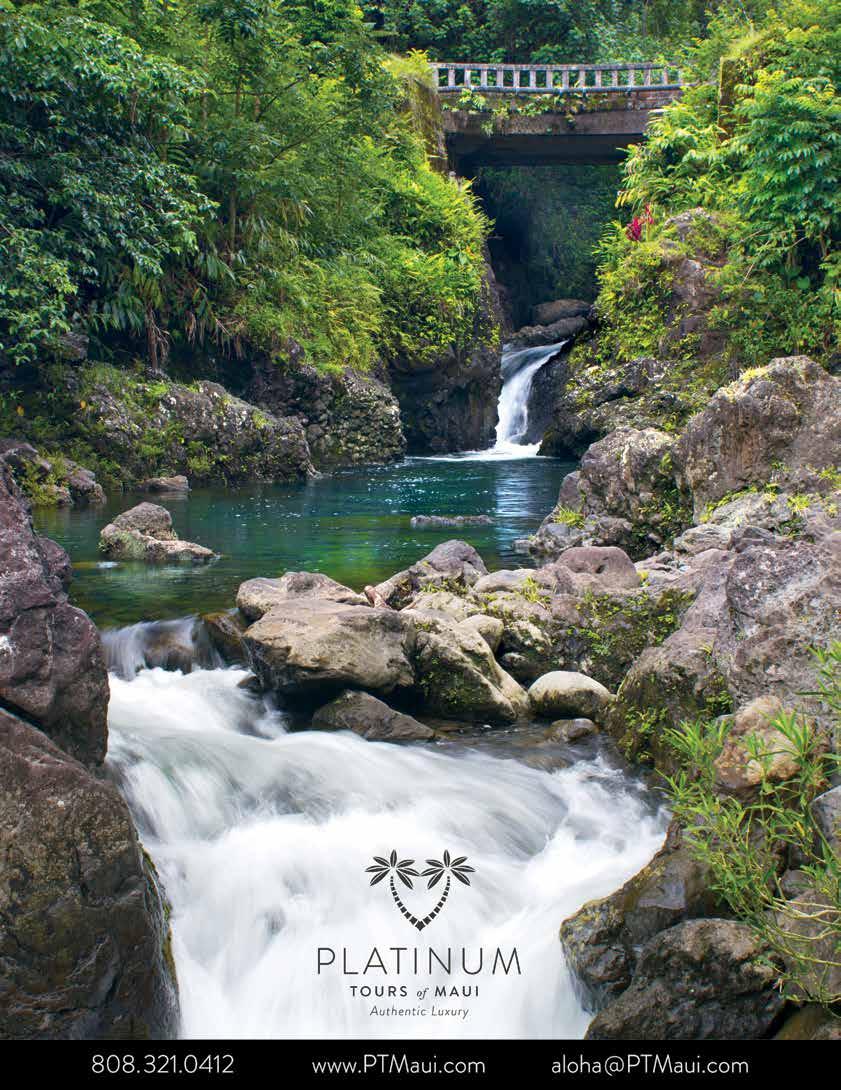

KE‘ANAE PENINSULA
ast mile marker on H na Highway is a sign for Ke‘anae, a picturesque peninsula well worth the detour. Rough waves crash on its rocky beaches, and the village found here consists of nothing more than a handful of houses hidden in the foliage and a beautiful rock-walled church built in 1856. Grab some shave ice or banana bread from Aunty Sandy’s, the only vendor in the area, and take in the dramatic clifs and high s rf of a i s north shore.
KAHANU GARDEN
H na is often described as a i s last tr ly Hawaiian place and there is no better spot to experience this truth than Kahanu Garden. Explore this peaceful

botanical garden, home to plant species from throughout the Pacific, one of the last native hala tree forests, and Pi‘ilanihale, the largest heiau in Polynesia. Don’t be shy to talk to the friendly park staff—they are eager to share their knowledge of Hawaiian culture.
TO DO:
KAIHALULU RED SAND BEACH
You get to Kaihalulu Bay the same way you get to any of Hawai‘i’s best spots: from an unmarked trail at the end of Uakea Road and over sketchy, somewhat dangerous, terrain. This 10-minutelong hike delivers stunning views of the water, and leads to the perfect crescent
Platinum Tours of Maui is a boutique touring company that features a fleet of customdesigned luxury transportation equipment. General manager Napua Hueu curates the company’s authentic approach to hospitality with local staff who provide genuine island
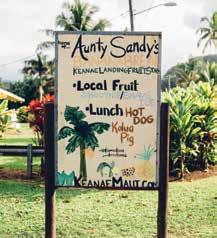
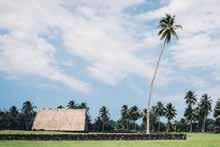
of red sand. Here, the rocky pinnacles create a naturally sheltered cove ideal for snorkeling. Bring your mask, but leave your judgments behind: This nude beach will likely have a naked hippie or two, along with a lot of tourists.
KE‘ANAE PENINSULA:
Located past mile marker 16 on H ā na Highway.
KAHANU GARDEN:
650 Ulaino Rd.
Open Monday–Friday, 9 a.m.–4 p.m. Saturday, 9 a.m.–2p.m.
$10 entrance fee, guided tours available with reservations.
experiences guided by cultural sensibility, which differentiates the company so much so that it is thriving in its first years of business. While Platinum Tours of Maui is considered the specialist on the Road to Hā na, the company can create an itinerary for any touring interest, island-
wide. In addition, the company can accommodate private airport transfers and extensive concierge services.
For more information, or to schedule a tour, visit ptmaui.com.
90 | FLUXHAWAII.COM
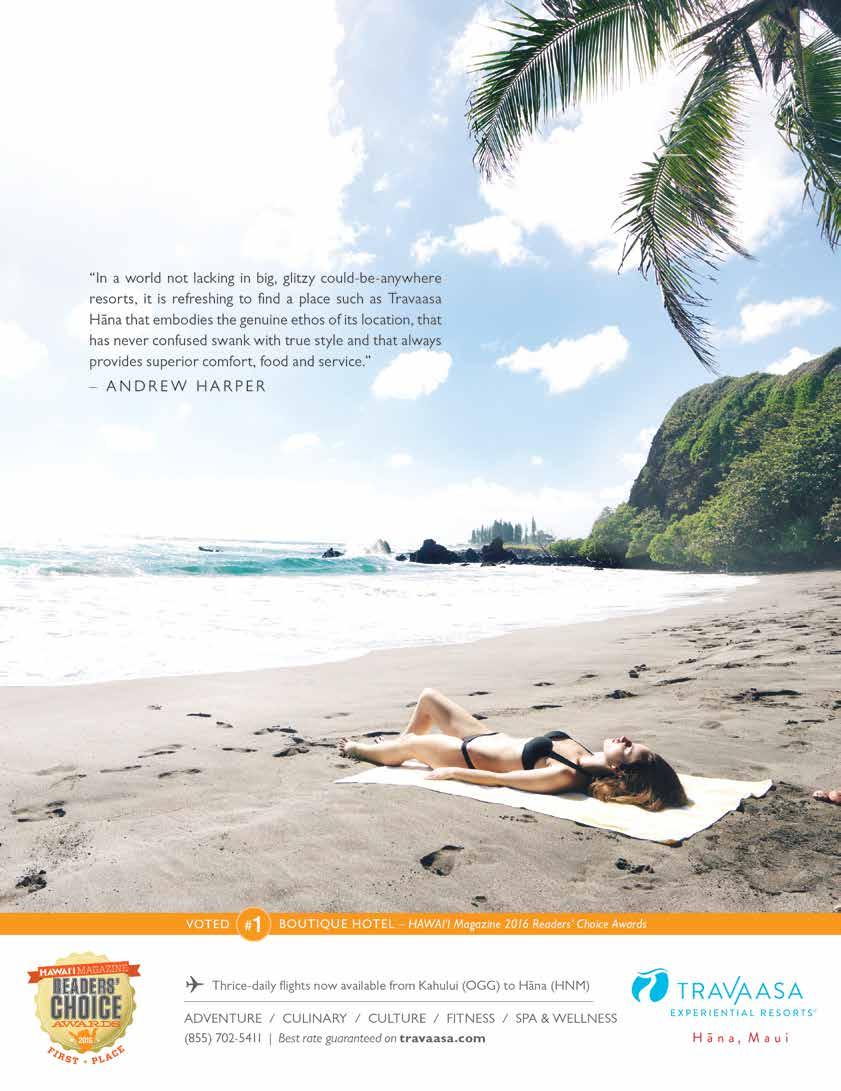
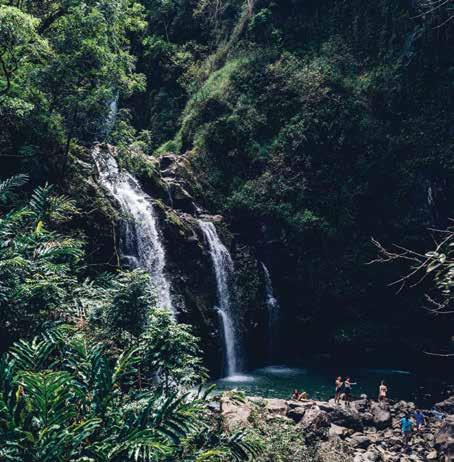
WAI‘ Ā NAPANAPA STATE PARK
You may be looking for a black sand beach b t at ai napanapa tate ark ai napanapa is Hawaiian for glistening water yo ll get a lot more. ocated at the end of ai napanapa oad of H na Highway a small road leads past old rock walls to camping areas in the trees. The coastal trail promises incredible views of lava rocks jutting from the ocean, and leads past sea caves to the black sand beach.

HIKE TO A WATERFALL
It would be a sin to drive this far through the rainforest and never step foot in all its greenery. There are countless waterfalls along the oad to H na both visible and hidden, but some of the best can be fo nd past H na. or instance the pools at he o lch also known as the Seven Sacred Pools, are one of the area’s most famous sights, and are located in the Haleakal ational ark st min tes so th of H na. short hike brings you to tiered pools fed by
Located at the end of the famous Road to Hā na, Travaasa Hana sits on 69 acres along Maui’s secluded eastern coast, surrounded by lush grass fields, palm tree groves, and the shores of Kaihalulu Bay. “In a world not lacking in big, glitzy, could-beanywhere resorts, it is refreshing to find a place such as Travaasa Hana that embodies the genuine ethos of its location, that has
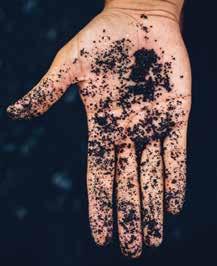

he o lch perfect for swimming when the water is low—while a longer hike p the p wai rail leads to the 400-foot Waimoku Falls. More adventurous travelers looking for a less crowded area should ask locals for directions to Waioka Pond (also known as en s ool located st past H moa each on H na Highway. he pah l entrance to Haleakal ational ark is fo nd at mile marker on H na Highway; $15 entrance fee per vehicle.
never confused swank with true style, and that always provides superior comfort, food, and service,” says the luxury travel company Andrew Harper. The extraordinary destination has been recognized as a stand-out travel experience, voted “#1 Hotel/Resort for a Romantic Getaway” and “#1 Boutique” Hotel” in Hawaii Magazine’s 2016 Readers’ Choice Awards.
A day at Travaasa takes guests on an unforgettable journey with distinct offerings—adventure, culinary, culture, fitness, and spa and wellness—all while offering guests the spirit of Hawai‘i.
Travaasa Hana is located at 5031 Hana Hwy. For more information, visit travaasa.com/hana.
92 | FLUXHAWAII.COM

Experience
Respite
Escape to this private getaway destination, here a r d u uri us erin s a ai s.
TEXT BY HAREN SORIL
COURTESY
IMAGES
ON TOP WITH HOTEL WAILEA
| PROMOTIONAL |
The first and only Relais & Châteaux property in Hawai‘i, Hotel Wailea offers travelers a Europeaninspired elegance infused with relaxed island luxury from its perch 300 feet above sea level. Set within the most exclusive resort

community on Maui, the ultra-private, adults-only hotel is designed uniquely for couples, and guests will be engulfed by the magic of south Maui’s breathtaking sunsets and panoramic ocean views. Hotel Wailea’s 72 suites each boast a contemporary beach house design with separate living rooms pri ate l nai and kitchenettes. Personalized guest programming is centered on authentic island experiences, while the hotel’s ever-evolving culinary program boasts a unique take on seasonal dining utilizing Maui-grown ingredients, including those from the hotel’s own organic garden. From exclusive services at Wailea Beach by day to stunning views and awardwinning dining at night, Hotel Wailea is a luxurious respite that embodies the spirit of Maui. It was even oted est Hotel in a i in Condé Nast Traveler Readers’ Choice Awards in and Hotel in ailea rip d isor Certificate of Excellence 2015.
CAPISCHE? A FINE CULINARY EXPERIENCE
Tucked away in a corner across from Hotel Wailea’s lobby exists a restaurant of culinary gold. A Relais & Châteaux restaurant property, Capische? presents
CAPISCHE?:
For more information, call 808-879-2224 or visit capische.com.
Image by Haren Soril
94 | FLUXHAWAII.COM ESCAPE | WAILEA |
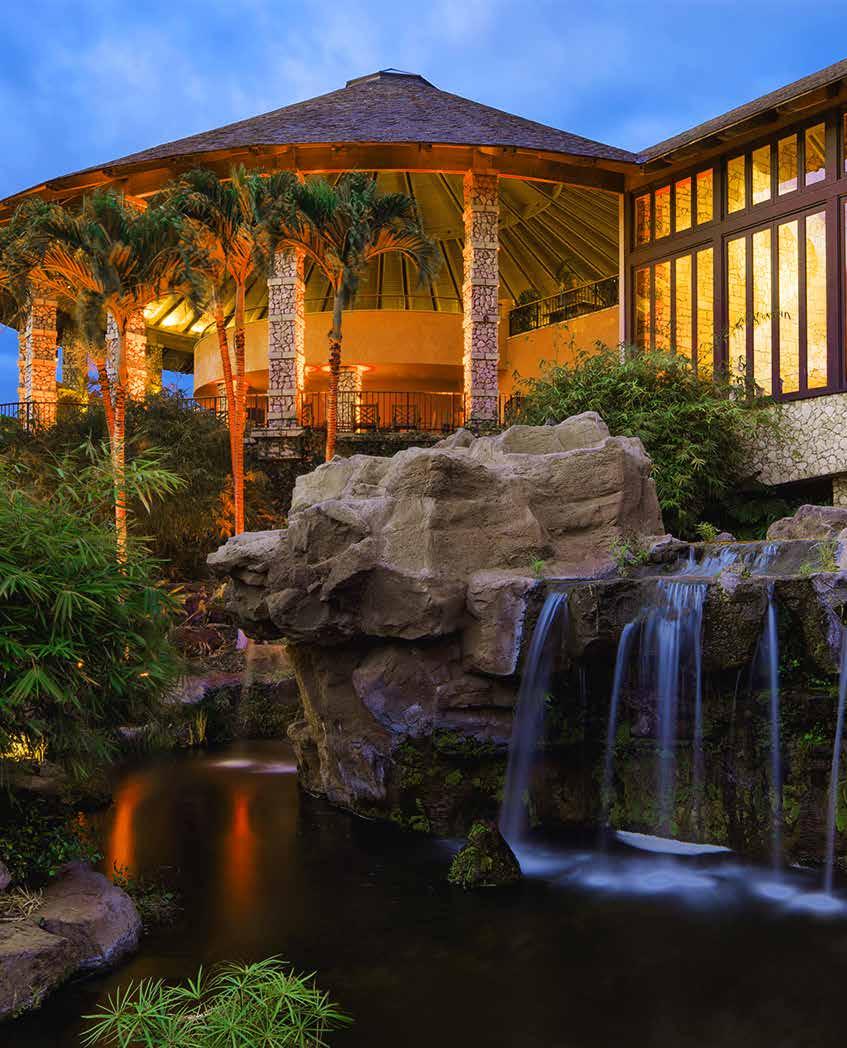
FLUXHAWAII.COM | 95 HOTEL WAILEA: For more information, call 808-874-0500 or visit hotelwailea.com
a fusion of southern French and northern Italian cuisine with a Mediterranean twist and acifc slands farm to table air. he resta rant s seasonal menu features freshly grown produce from Maui, local catch from Hawaiian Islands waters, and immaculate choices of meats and cheeses from around the globe. All this is served alongside an extensive wine list with varietals from regions around the world, as well as a specialty cocktail menu. As if that wasn’t enough, the views alone make a visit to Capische? worthwhile. Diners can opt for seating on the l nai which boasts dramatic views of south Maui; in the garden, where the vibrant sights and scents are only matched by what’s being served to you; in a private treehouse, where a personal chef sets the tone for a magical evening; or at the chef’s table, the ultimate in private luxury. Reservations are recommended at this popular restaurant, however bar and lounge areas are available on a frst come frst ser ed basis.
WAILEA’S HOLE IN ONE
Upon the greenest slopes and fields of Wailea, you’ll find three golf gems that boast the recognition of both quality and beauty. Honored by professionals and critics around the world, The Wailea Golf Club is home to the Blue, Emerald, and Gold golf courses, as well as some of the most outstanding views you’ll find in Wailea.
A STAR - STUDDED FILM FESTIVAL
Held once a year on the Wailea Emerald and Gold golf

courses, this seasonal event is known as one of Wailea’s largest summer festivities. With guest appearances by Hollywood celebs, loads of lavish parties, and movies being projected on a large white screen beneath the stars, the Maui Film Festival is not to be missed. This multi-day event features screenings at The Wailea Golf Club, Wailea Beach Marriott Resort and Spa, and The Maui Arts & Cultural Center in Central Maui. There are three culinary events, which run throughout the festival, starting with the Taste of Summer, followed by the Taste of Chocolate and the Taste of Wailea, where Maui’s top chefs present an array of

delectable menu items. The Maui Film Festival caters to a wide variety of audiences, ser ing p the fnest entertainment you can watch or taste.
THE SHOPS AT WAILEA Indulge in the luxury of Wailea with rows of the most deluxe island shopping, dining, and entertainment. Conveniently located in the heart of Wailea, this mall is specifically tailored to fit all your shopping, dining, island essentials, and souvenir gifts needs. The Shops at Wailea is your one-stop destination and carries the items you need to help make your vacation experience unforgettable.
While on Maui, visit the Sheraton Maui Resort and Spa, where Gabriel Harvey has created the popular Mill Camp Mojito, a cocktail inspired by generations of immigrants who came to Hawai‘i to work in the sugar plantations. The drink pays homage to the blend of cultures that makes up Hawai‘i today. It


THE SHOPS AT WAILEA:
For more information, call 808-891-6770 or visit theshopsatwailea.com
WAILEA GOLF CLUB:
For more information, call 808-875-7450 or visit waileagolf.com
MAUI FILM FESTIVAL: June 15–19, 2016
For more information, call 808-579-9244 or visit mauifilmfestival.com
highlights Chinese culture with fresh ginger, Japanese with shiso leaves, Korean with kim chee powder, Filipino with calamansi, and Puerto Rican culture with its mojito-style. The Mill Camp Mojito is the perfect cocktail to cap a day of adventure, hard work, or fun in the sun.
96 | FLUXHAWAII.COM

The World that Was Here First
Two days from makai to mauka, and back again, along Waimea Canyon.
TEXT BY ANNA HARMON
IMAGES BY BRYCE JOHNSON
Before you begin winding your way up Highway 550, also known as Waimea Canyon Drive, let’s get one thing straight: Though it has been passed around on the coconut wireless (and Internet), Mark Twain never wrote of Kaua‘i, hence he never dubbed Waimea anyon he rand anyon of the acific. en if the famed author had visited

the Garden Isle, Arizona s Grand Canyon wasn’t given its iconic name until 1871, five years after Twain ever even set foot in the islands. That being said, Waimea Canyon has had at least one famous visitor. The same year that the Grand Canyon was christened so, Queen Emma traversed from Waimea Town on horseback all the way to Alaka‘i Swamp in the highlands of Kaua‘i with musicians, hula dancers, retainers, and companions in tow.
It is at this bog-scattered rainforest plateau that the Waimea River originates, fed by rainfall from nearby Mount Wai‘ale‘ale, one of the wettest spots on Earth. The actual name of Kaua‘i’s gorge, aimea means reddish water and is a ftting description and name that applies to the canyon, the river, the town on the coast, and the nearby bay where freshwater meets acifc Ocean. Waimea River gets its color from the land’s red dirt, and runs along the base of the canyon, which is 3,600 feet deep, 1 mile wide, and 10 miles long. Viewpoints along its rim ofer sights of waterfalls resplendent. Back in ke e tate ark isitors can even peer into fertile Kalalau Valley. Nature holds sway here, be it via endemic acacia koa and hi a leh a or Japanese sugi cedars and redwoods planted in the early 1900s. Native
Leave city lights behind for that of twinkling stars at Kō ke‘e State Park.
98 | FLUXHAWAII.COM ESCAPE | WAIMEA |
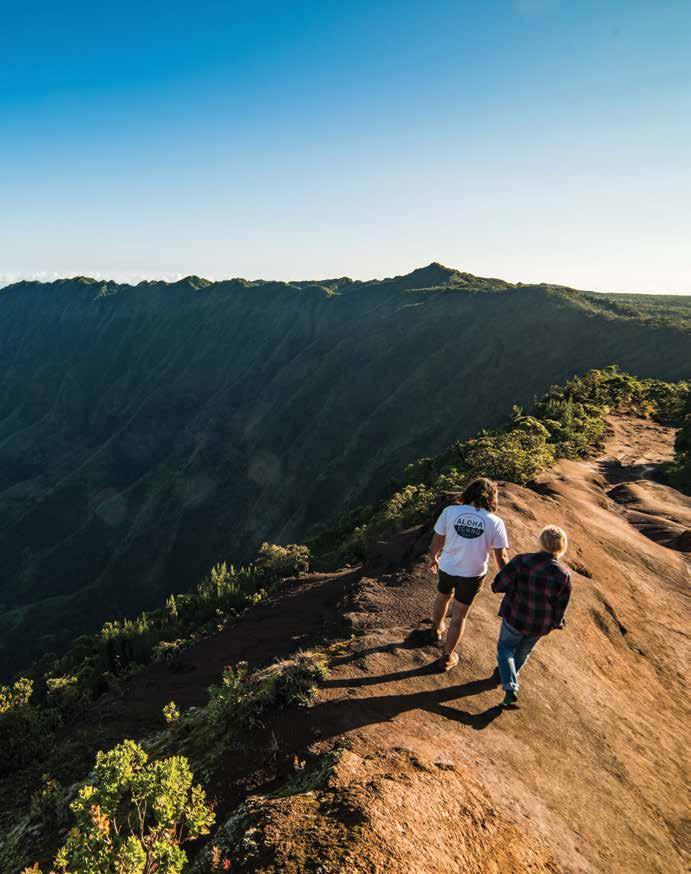
FLUXHAWAII.COM | 99
Peer into fertile Kalalau Valley from the lookout located at mile marker 18.
honeycreepers occasionally dart between trees. While Waimea Canyon itself remains relatively untouched, nearby, at the seaport town of Waimea, local businesses provide visitors and residents with h man necessities like cofee poke, and cocktails. Beaches also in close pro imity ofer the ideal viewpoint to watch the sun go down from the westernmost populated island in the Hawaiian island chain.
FOLLOW WAIMEA CANYON FROM MAKAI TO MAUKA, AND BACK AGAIN, AND GET A TRUE FEEL OF WHAT THE REGION HAS TO OFFER.
1 | top at apa cks ofee Shop in Waimea town to get cafeinated for the dri e p Highway 550.
2 | Head to G’s Juicebar to balance o t yo r cofee with a healthy acai bowl for breakfast. Try the Rambla, which features cacao, honey, and almond.
3 | Visit Ishihara Market for lunch to go—the Waimea establishment serves plate lunches, including poke, until 1 p.m., as well as snacks.
4 | Drive along Highway 550 to YMCA’s Camp Sloggett, which is reached by taking the first right after the t rnoff to ke e odge (located between mile markers 15 and 16). Follow this dirt road for half a mile until you reach a wooden amp loggett sign which marks the camp. Here, pitch a tent or set up in a cabin (available when reserved in advance). In the winter,
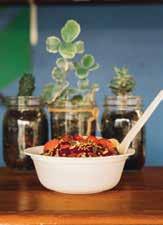
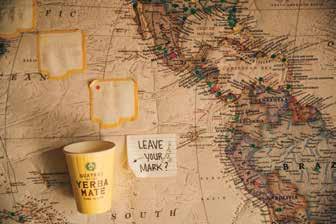

While visiting Kaua‘i, be sure to stop in at The St. Regis Princeville Resort, which offers guests a unique version of the Bloody Mary using locally inspired ingredients. The St. Regis Princeville’s Aloha Mary was inspired by the unforgettable 1958 epic, South Pacific , which
was filmed on the island of Kaua‘i. The Aloha Mary combines ingredients sourced from throughout the Pacific Rim region, such as Sriracha, wasabi, organic Hawaiian Ocean Vodka, and smoked guava wood sea salt, which imparts a rich and complex oceanic flavor to the cocktail.
100 | FLUXHAWAII.COM
remember to pack warm, as nighttime temperatures can drop to 40 degrees.
5 | Follow Highway 550 to its end, and enter the ali ona orest eser e. laka i Swamp Trail sets out from a parking area a quarter-mile in. A full 3.5 miles each way along a muddy, wooden boardwalk that keeps trekkers from sloshing through bogs, this hike ofers incredible iews of both ainiha and Hanalei valleys at its endpoint, as well as a myriad of native wildlife en route. The trail is typically very muddy, so dress appropriately.
6 | Head back to mile marker 18 to catch the sunset from the Kalalau Lookout. Afterwards, return to camp to enjoy the starry sky and quiet surroundings.
7 | In the morning, get breakfast from the café at the ke e odge which is located ne t to ke e at ral History se m.
8 | On your way down, stop at the parking lot located between mile markers 14 and 15. This is where Canyon Trail sets out from (there is a trailhead sign, but it is slightly out of view from the road). The 1.5-mile hike will take you to the head of 800-foot Waipo‘o Falls, which you may have viewed from lookouts on the way up. Note: In the summer, this waterfall may be dry.
9 | After returning the same way you came, head back west out of Waimea town on Highway 50. This route will take you to a sprawling white sand beach at the foot of the ali oast sea clifs located within olihale State Park. While it can be hot here during the day, the sunset is spectacular. Just make sure that your car is 4-wheel drive, otherwise, the sandy, rutted roads can pose a problem.
10 | Once the sun has gone down, head back to Saddle Room in Waimea to cheers to your travels with drinks and cocktails. However, it is a small town after all, so know that this bar only has evening hours on Thursday, Friday, and Saturday.

The Edge
A walk through Kalihi presents a surprising escapade—a retrospective adventure—you just have to look around.
TEXT BY REBECCA PIKE
IMAGES BY JOHN HOOK
Maybe I like Kalihi because I’m from The Bronx—once wilderness and brush, then farmed for generations, and within the past century, developed for industrial purposes and housing. Both places have reputations as being a little rough. If there is a h la of hard knocks it s in Kalihi. Need somewhere to go because Chinatown is literally on fire due to the

bubonic plague epidemic? Hele to Kalihi. Moving to Hawai‘i to work a plantation? Go to Kalihi. Being exiled to Moloka‘i due to leprosy? You’re leaving from Kalihi. As far back as we can go, Kalihi has been a formidable place, though Papa and kea earth mother and sky-mother, are said to have found safety and subsistence in the valley. It was in Kalihi that Pele hid her supernatural vagina (which had already been tossed over to Puna by her sister, Kapo, who was straight outta Kalihi herself) that her former lover, the pig god Kamapua‘a, had been hunting. By the early 1900s, Kalihi had become a residential district of middle- and upper-class Hawaiians and part-Hawaiians, and was also attracting Chinese and Portuguese residents. Many of them settled in Kalihi, and in the decades to come, Japanese, Puerto Ricans, Filipinos, Samoans, Koreans, and Southeast Asians followed. Cannery workers, dairy workers, farmers,
“Each night was a homecoming, like touching the roots of feeling. Here at dusk, folks stepped from the working world into a kind of genesis. They who had seldom heard of unions, Sundays off, or equal wages, put down lunch pails, took off slippers and shoes, and stretched bare feet against soil that was regenerative and giving.”
—Kiana Davenport, Song of the Exile
102 | FLUXHAWAII.COM ESCAPE | KALIHI |

FLUXHAWAII.COM | 103
Tamashiro Market, at 802 N. King St., for when you can’t make it directly to the fish auction, but you still want absurdly fresh fish.
schoolteachers, storekeepers, and others all lived and worked in Kalihi. In the 1920s and 1930s, the population ballooned as affordable housing and its proximity to downtown Honolulu and U.S. military bases made the area even more appealing.
Sculptor Jerry Vasconcellos grew up in Kalihi Valley in the 1950s, across the street from oe im s ery frst cabbage farm and kimchi processing plant. One of a dozen or so local boys on the block, Vasconcellos remembers the kids’ prostatehood platform e want oca ola as well as their routine teenage posturing against the daunting crews of Kalihi Waena (central Kalihi), Kalihi Uka (residential uplands), and Kalihi Kai (industrial zone makai of the highway). This industrial area with very little coastal surf, was where you could go to get anything, recalls Vasconcellos. The original City Mill, the only one in town, was there, as was igwam. t was a poor man s Liberty House, if you will, b t with a lot more ariety according to Vasconcellos. o didn t go there for fashions, which nobody around here knew or cared abo t anyway. rowing p in Kalihi was wonderful, says the sculptor, who still lives in the streamside home he grew up in.
At least some vestiges of these bygone times do still stand, though the sticky fngers of growth ha e long tickled this region. here s no empty space in Kalihi anymore lamented former realtor dolf e Mendonca in a Kalihi overview published by the
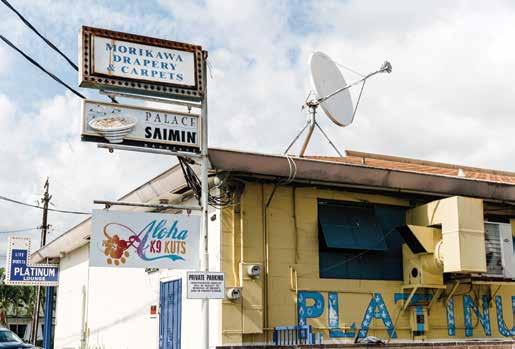
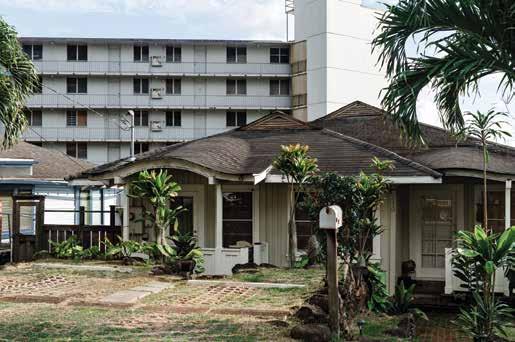

If you find yourself on O‘ahu, visit Rocky Higgins at the Sheraton Princess Kaiulani’s Splash Bar and Bento to try his Kahana Splash cocktail. Inspired by stories of Princess Victoria Ka‘iulani—who loved to invite family, friends, and dignitaries to ‘Ā inahau, her summer retreat
located where the hotel now stands—Higgins created a frothy, delicious ice cream drink evocative of the Victorian era that celebrates the flavors of Kona coffee, macadamia nuts, and coconut. It is now served poolside for all to enjoy.
104 | FLUXHAWAII.COM
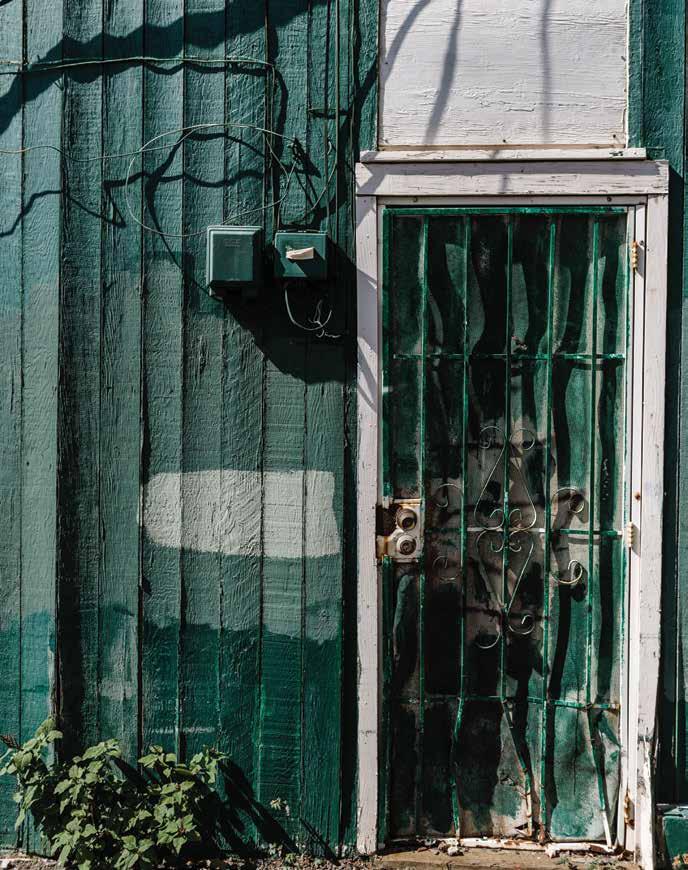
At least some vestiges of Kalihi’s bygone times do still stand, though the sticky fingers of growth have long tickled this region.
FLUXHAWAII.COM | 105
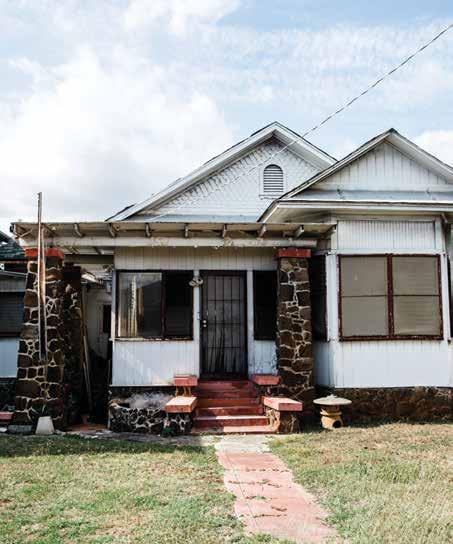
University of Hawai‘i’s College of Social ciences. sed to be egetable gardens ower gardens taro patches gra ing land, chicken farms. … No place was too far to walk within Kalihi. … There were fewer ho ses back then. t s flled in b t it feels a lot emptier now.
With some significant exceptions, most of the old homes and lanes in Kalihi are gone. Some of the newer homes, all of which dwarf their aging, plantation-style neighbors, seem to scream p lence goddammit in the form of metallic fences, wallto-wall curved balustrades, and parking for many, many vehicles. Additionally, the recent scourge of beige, multi-unit boxes disguised as homes—even worse than their brutalist 1970s counterparts—has touched the alley. till as endonca noted n many respects, it’s beautiful. I never
understood why [Kalihi is considered a bad place]. I’m sorry that it’s inherited such a bad carryover. I don’t think it deser ed it.
In fact, author Kiana Davenport set part of her epic novel, Song of the Exile , in residential Kalihi in the mid-1900s. Here, the protagonist, Keo, comes home after a night of work at a aik k hotel awn coming p rple o er the Ko‘olaus, he strolled up Kalihi Lane, west of downtown Honolulu. A lane so narrow he could reach out his arms, almost touch bushes on either side. A world remote, unspoken for, so modest there was the temptation to hate it. There was the fear this was all he would know. Wood-frame bungalows going to termites, their porch steps scalloped by generations.
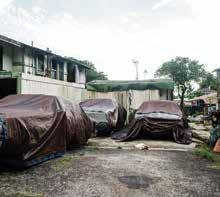

KALIHI BUSINESSES OF NOTE:
FOUR SEASONS ENTERPRISES
TRAVEL AGENCY AND CRACK SEED STORE:
Because sometimes you need that li hing mui to go.
721 Mokauea St.
HAWAII ACADEMY:
A round-the-clock business with gymnastics, tumbling, and even ninja classes for all ages.
1314 Moonui St.
WOODCRAFT:
The professional woodworker’s resource.
1311 Kalani St.
106 | FLUXHAWAII.COM

With some significant exceptions, most of the old homes and lanes in Kalihi are gone, but in many respects, as Adolf “Duffie” Mendonca once said, it’s still beautiful.
FLUXHAWAII.COM | 107



O‘AHU’S BEST:
Hyatt Regency Waikiki Beach Resort
Celebrating 40 years of aloha
When its doors opened 40 years ago, Hyatt Regency Waikiki Beach Resort and Spa became one of the world’s most popular destinations in Hawai‘i. With exceptional personalized services, acclaimed entertainment, and lavish amenities, the hotel quickly established itself as the heartbeat of aik k .
Today, the spirit of aloha is a legacy that the establishment continues with its commitment to maintain the highest standard of service, greeting guests at every turn. As with the past 40 years, Hyatt remains a driving force, setting the trend for what is modern and intuitive to the needs of all travelers. With a $100 million investment
| PROMOTIONAL |

last year, each of the 1,230 newly designed guest rooms at Hyatt Regency Waikiki Beach Resort and Spa are proof of the hotel’s unwavering belief that every detail makes a difference. From 55-inch televisions, clean designs, customized bathrooms, and enhanced connectivity— perfect for the free Wi-Fi—the rooms are furnished with all the elements that matter most to today’s travelers. Additionally, guests can still find some of the best amenities in the area, and conveniently, all on property. ith aik k s first resort spa a Ho ola world class shopping the bi weekly aik k armers arket headline entertainment from local greats like Taimane Gardner, and exceptional Hawai‘i Regional Cuisine at Japengo, Hyatt Regency Waikiki Beach Resort and Spa remains a central part of the story of aik k .
For reservations, call 800-55-HYATT, or visit waikiki.hyatt.com.

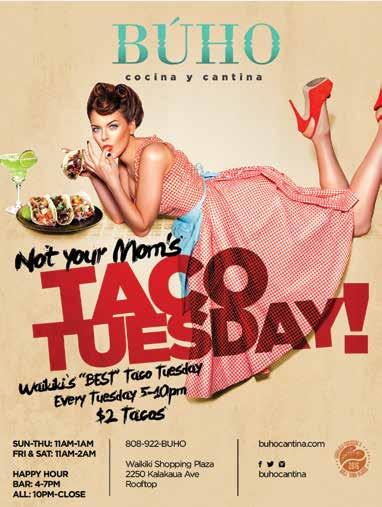

Starwood Hotels and Resorts in Hawai‘i: After Hours
SHERATON PRINCESS KAIULANI
Four exciting entertainment options set the tone for a memorable evening in aik k . tart with the capti ating Polynesian performance Te Moana Nui – Tales of the Pacific, featuring authentic music and dancing that weaves legends of Polynesia with Old Hawaiʻi. eeling a bit nostalgic atch the electrifying Fourever Fab as they jam out favorite hits from The Beatles. For a good laugh, the hilarious AlohaHa Show showcases live comedy paired with animatronic characters, impersonations, and unique robotics.
nd the poolside plash ar and ento is the perfect place to unwind during late-night happy hour.
MOANA SURFRIDER, A WESTIN RESORT AND SPA
The Banyan Courtyard continues a 115-year tradition as a favorite gathering spot for visitors and kama‘aina (locals) to enjoy daily and nightly live performances of acoustic guitar, contemporary Hawaiian music, and more. Don’t miss Mele at the Moana, li e concerts by Hawaiʻi s hottest musical talents, on the last Friday of every month.
THE ROYAL HAWAIIAN, A LUXURY
COLLECTION RESORT
A Royal Hawaiian Luau, ‘Aha ‘Aina, aik k s only oceanfront dinner and show, is a culinary and sensory celebration in grand Royal Hawaiian style. It is held Monday evenings at The Royal Hawaiian’s Ocean Lawn, with the breathtaking backdrop of aik k Beach and Diamond Head. After the show, visit the oceanfront Mai Tai Bar
for a quintessential island evening experience. Sip a Royal Mai Tai under the stars while the sound of the rolling surf blends harmoniously with sweet tropical music.
SHERATON WAIKIKI
To amp up the evening, head to RumFire Waikiki restaurant and bar in the Sheraton Waikiki to experience liquid aloha (featuring the largest selection of vintage rums in aik k to be e act inno ati e Pacific Rim of Fire menu selections, entertainment, and dancing in an indoor-outdoor setting overlooking iamond Head and aik k each. RumFire brings a new level of excitement and energy to its already hip and happening en e on aik k each with more than 10,000 feet of pure energy and excitement.
Call Waik ī k ī reservations at 808-921-4600. Ask about validated parking and happy hour specials.
110 | FLUXHAWAII.COM IN FLUX | PROMOTIONAL |
Waik ī k ī ’s Gold Coast
Discover redefined boutique service with a stay at Lotus Honolulu at Diamond Head ideally sit ated on aik k s old Coast. Imagine starting your day with the warm Hawaiian sun peeking into your room to greet you. Next, charge up your day by sipping your morning coffee—brewed from the in-room iperEspresso machine featuring Illy coffee—while gazing upon vivid ocean waves and majestic Diamond Head from the pri acy of yo r ery own l nai. he e citement of aik k lies within a stone’s throw of the hotel, just beyond Kapi‘olani Park, but first, yoga. Meander over to the Lotus Honolulu’s outdoor yoga class to stretch and find your center, then refuel with a healthy breakfast on the second floor

overlooking the serene park. Now you’re ready to head out for the day’s casual adventures, from self-guided tours on beach cruiser bikes to an afternoon spent lo nging on aik k each with beach chairs and towels in tow—all of which are amenities provided by the hotel’s friendly staff.
As the daylight drifts away, join the
daily wine hour and chat with new friends in the hotel’s lobby. The rest of the evening is at your disposal, so why not come and create your own story in paradise?
For more information, visit lotushonoluluhotel.com
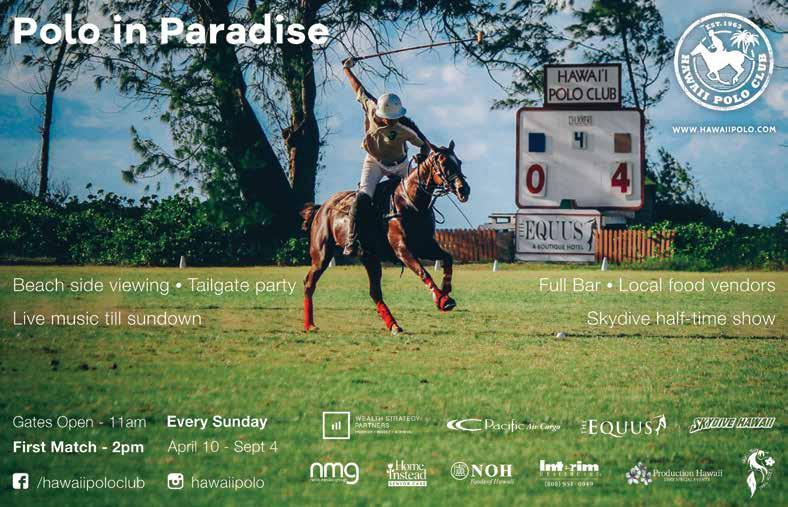
IN FLUX | PROMOTIONAL |
Making Pâté de Lapin
A trip to France to discover one’s culinary roots.
TEXT BY AND IMAGE COURTESY OF TESS BEVERNAGE
We’re in a tiny butcher store that my grandmother swears by. There’s a man in his 80s behind the counter who greets us without pausing from his present occupation: taking apart an entire animal. We’re in Peynier, a town only a few miles away from where my mom grew up, in the South of France. The village is tiny—it’s truly a village— complete with winding cobblestone paths. We’ve come for a rabbit to recreate a dish that my great-grandmother was known for: pâté de lapin While the butcher wraps up the lapin, or rabbit, my mom asks me of the coming culinary ordeal t s a fi e day process are yo sure you want to do it? People don’t cook like this anymore.
The whole purpose of my trip to France to rediscover my family’s culinary roots in Provence can be captured by the spirit of this very moment. Last year, I left my public relations job in Honolulu, and headed to Vancouver, Canada to attend North West Culinary Academy. Afterwards, it only made sense to continue my education where it all started, in my family’s terroir, Provence. My mother was raised here, but when she was 20, she moved to Montreal, Canada, where she met my father, who had also emigrated from France.
My older brother and I were born in Montreal. Eight months after I arrived into the world, my mom decided she couldn’t bear another frigid winter and wanted to move somewhere warm. My
dad, having grown up surfing in France, chose Hawai‘i as our family’s next home, and it ended up being the perfect fit.
With roots in France, Canada, and now, O‘ahu, my mom felt it was very important to create a mini Provence in Kuli‘ou‘ou Valley, where I grew up. We only spoke French at home, and I spent my time by my mom’s side, learning our history through cooking traditional French dishes.
My mom has since moved back to Provence. It’s here, in her new home where we begin to make the pâté de lapin. As I prepare the rabbit for its multi-day marinade in wine and wild herbs, my mom explains that my greatgrandmother had a lapinier, where rabbits were raised in order to feed the whole family. With this, a beehive, pigs, chickens, and a thriving vegetable patch, all needs were met. My mom grew up in a very similar environment; her first memory of going to a grocery store for produce was at the age of 20, when she moved to Canada. Back then, my mom’s was a frugal way of life, but it was also one that produced deep familial connections with food and the land.
Over the next few days, I learn how to check and turn the rabbit regularly. When it’s time to start the pâté process, my aunt comes over to help remove all the small bones and unwanted parts. We gather around a table and reminisce about the rites of passage that we all experienced while cooking. As a child visiting my mom’s family in Provence, my most vivid memories are from my grandparents’ kitchen. At the age of 4, I remember being entrusted with plucking parsley leaves for tomate provençal. As I got older, I was given more responsibility, and with each small lesson, I was being taught my southern French roots.
hen the p t de lapin is fnished we plate the dish in the same way my great-grandmother would have done, and serve it to family members who have not seen or tasted it in 30 years. Some
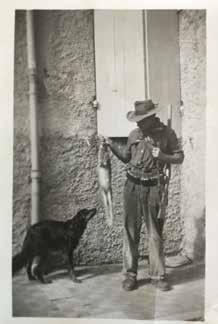
are brought back to their childhoods, while younger kin experience a piece of history for the frst time.
This is the last dish I learn to prepare, the grand finale of my threemonth visit to Provence. On this journey, my heart and mind unearthed priceless culinary instincts, family secrets that I transferred to paper for the first time. Now, future generations can carry on our traditions, wherever their roots may grow.
The writer’s great uncle in 1949 in Rousset, France at her greatgrandmother’s house, where her grandmother and grandmother’s siblings were born and raised.
Discover Bevernage’s culinary journey on Instagram @thefrenchlady.
112 | FLUXHAWAII.COM A HUI HOU





























 Timothy A. Schuler
Timothy A. Schuler





























































































































